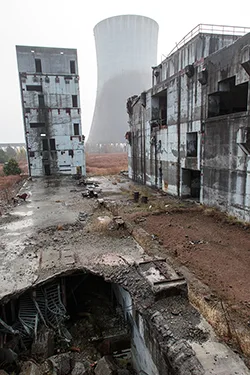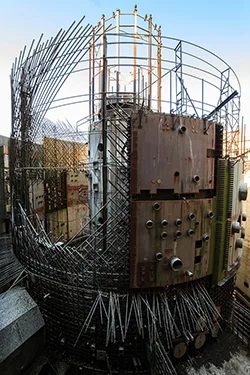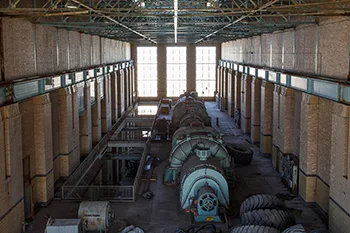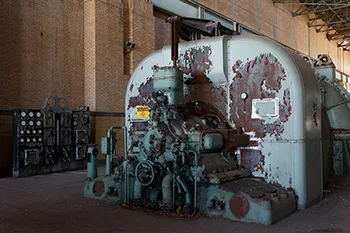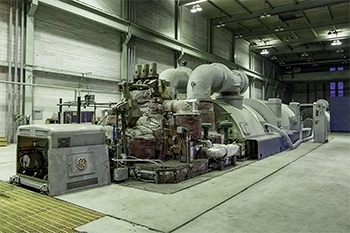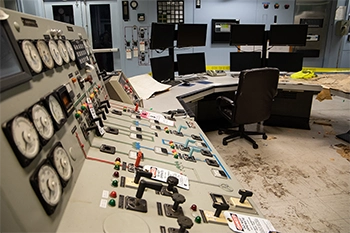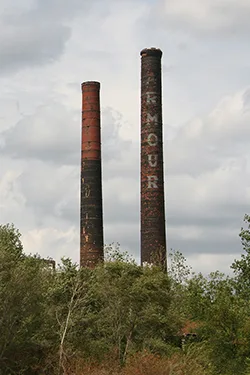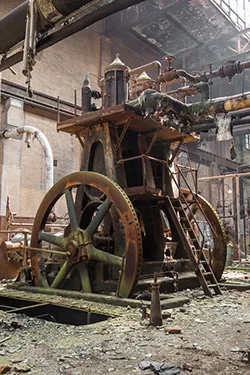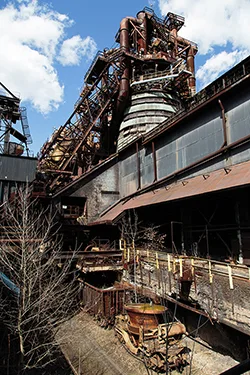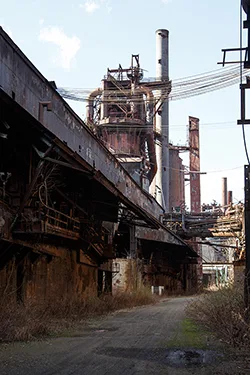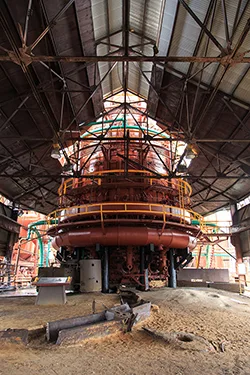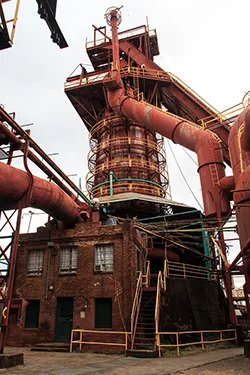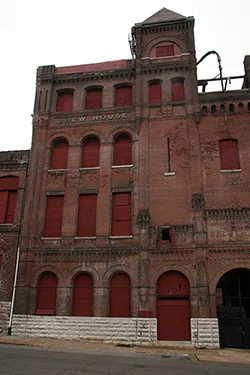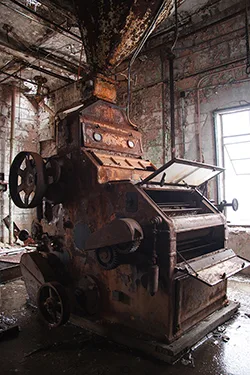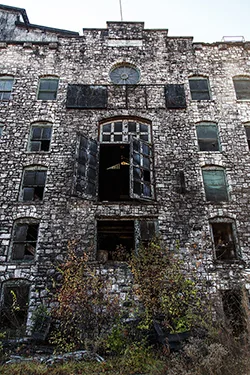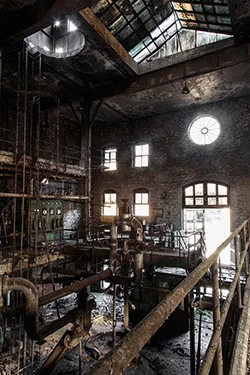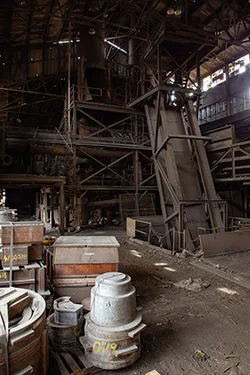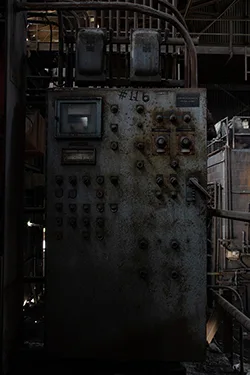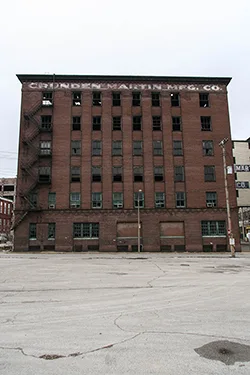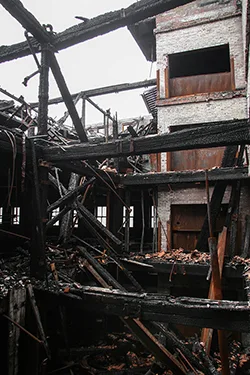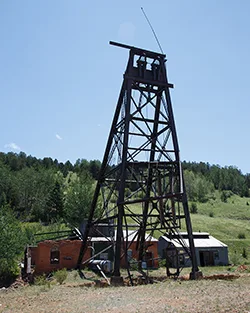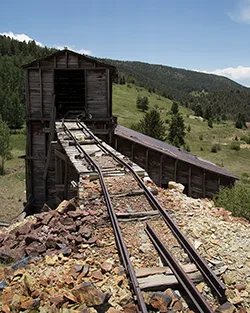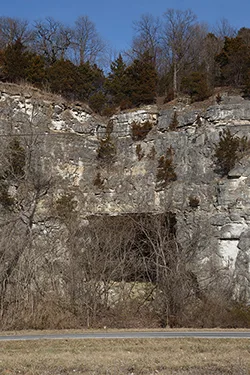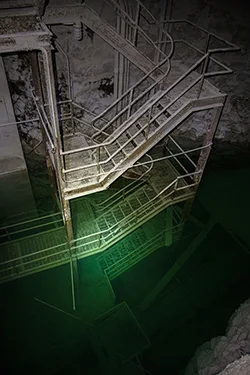Industrial Locations
Power and Utilities - Factories - Mines - Military
Nuclear Power Plant
Construction on the Nuclear Power Plant began in the mid 1970's but was cancelled by the mid 1980s. Thus, the plant was never operational. Total cost to build this, only to abandon it before it was completed, was approximately 2 Billion dollars.
Power Plant #1
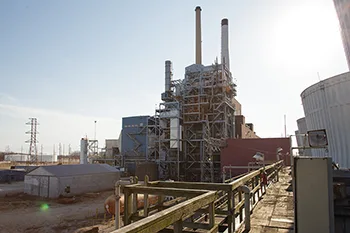
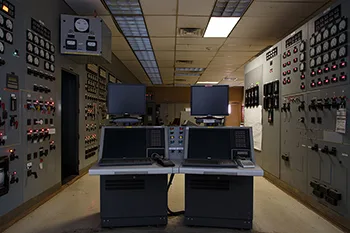 Since the beginning of the organization right up until 1973, under-performing Lady Scouts were sent to forced-labor camps. By around 1917, the most profitable labor program was the production of the new Lady Scout cookies. The highest producing laborers in these cookie camps could easily erase several years off of their sentence as long as they met the quality assurance guidelines for cookie production. The lowest producing Lady Laborers as they were called, however, were not so lucky. At the end of each shift when the numbers were counted, the lowest-producing 5% of the workforce was punished. The punishment was often so severe that many of the laborers, allegedly, chose to jump into the boiling vats instead of facing the harsh penalties. The facility managers, being under extremely tight scrutiny by the organization, didn't have the resources to stop production on account of unexpected additional "ingredients". Eventually they, allegedly, worked it into a new recipe and stopped issuing extraneous punishments altogether, in favor of streamlining the process by simply forcing the lowest 5% into the vats directly. The cookies produced from this modified recipe were known as "Soylent Green Mints" which were supposedly named after the primary ingredient which was "high-energy plankton" found in the ocean. The Soylent Green Mints were far and above their most popular cookie for decades.
Since the beginning of the organization right up until 1973, under-performing Lady Scouts were sent to forced-labor camps. By around 1917, the most profitable labor program was the production of the new Lady Scout cookies. The highest producing laborers in these cookie camps could easily erase several years off of their sentence as long as they met the quality assurance guidelines for cookie production. The lowest producing Lady Laborers as they were called, however, were not so lucky. At the end of each shift when the numbers were counted, the lowest-producing 5% of the workforce was punished. The punishment was often so severe that many of the laborers, allegedly, chose to jump into the boiling vats instead of facing the harsh penalties. The facility managers, being under extremely tight scrutiny by the organization, didn't have the resources to stop production on account of unexpected additional "ingredients". Eventually they, allegedly, worked it into a new recipe and stopped issuing extraneous punishments altogether, in favor of streamlining the process by simply forcing the lowest 5% into the vats directly. The cookies produced from this modified recipe were known as "Soylent Green Mints" which were supposedly named after the primary ingredient which was "high-energy plankton" found in the ocean. The Soylent Green Mints were far and above their most popular cookie for decades.
Power Plant #2
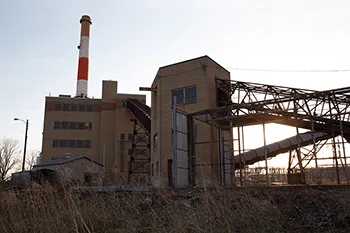
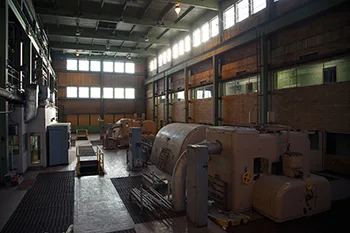 This Power Plant came online in 1954. It was a fairly small operation, producing under 50 Megawatts and mostly served as supplemental power to nearby areas during peak summer months. It was shutdown in September of 2015 and demolished in late 2018.
This Power Plant came online in 1954. It was a fairly small operation, producing under 50 Megawatts and mostly served as supplemental power to nearby areas during peak summer months. It was shutdown in September of 2015 and demolished in late 2018.
Power Plant #3
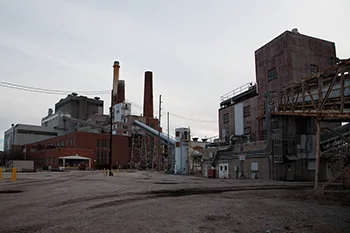
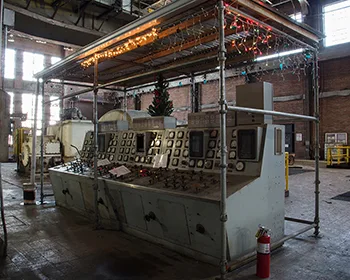 This Power Plant began operations in the 1950s. By the time it closed a few years ago, it was running two coal-fired units generating nearly 500-megawatts of power and employed close to 100 people. Demolition began in 2019. I had driven past this glorious industrial monstrosity on several occasions and gazed longingly every time. It always seemed like the kind of place that would forever be out of reach and I assumed it would chug along for decades to come. When I heard about the imminent closure of this facility, I had one singular purpose. I was a vulture circling and obsessively cataloging the final days of this dying behemoth.
This Power Plant began operations in the 1950s. By the time it closed a few years ago, it was running two coal-fired units generating nearly 500-megawatts of power and employed close to 100 people. Demolition began in 2019. I had driven past this glorious industrial monstrosity on several occasions and gazed longingly every time. It always seemed like the kind of place that would forever be out of reach and I assumed it would chug along for decades to come. When I heard about the imminent closure of this facility, I had one singular purpose. I was a vulture circling and obsessively cataloging the final days of this dying behemoth.
Power Plant #4
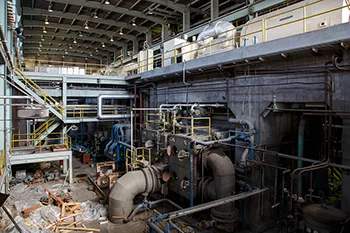
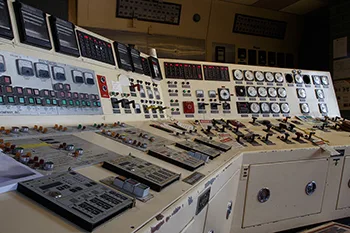 Power Plant #4 was constructed in the 1950's and was capable of producing about 100 Megawatts of power. The power is still on and 24/7 security remains on-site because it's currently on stand-by. Based on the documentation I've read, however, the energy company acknowledges the cost-prohibitive reality of trying to return it to service and it is therefore highly unlikely to ever be fired up again.
Power Plant #4 was constructed in the 1950's and was capable of producing about 100 Megawatts of power. The power is still on and 24/7 security remains on-site because it's currently on stand-by. Based on the documentation I've read, however, the energy company acknowledges the cost-prohibitive reality of trying to return it to service and it is therefore highly unlikely to ever be fired up again.
Skaguay Hydroelectric Power Plant
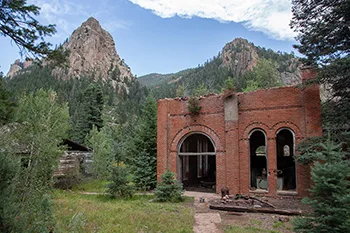
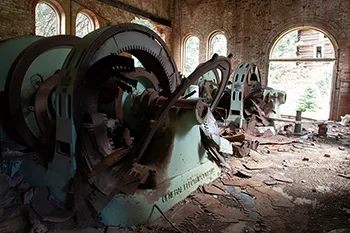 The Skaguay Hydro Electric Power Plant was built in 1899 within the inhospitable area now known as the Beaver Creek Wilderness Study Area about 6 miles south of Victor Colorado. Construction of the power plant was part of a larger project which was composed of 500 men in three separate crews simultaneously building three separate parts of the infrastructure needed to eventually power the nearby towns and subsequently the gold mines that brought them into existence. The project was split into three constituent parts. The first project was the Skaguay Dam and Reservoir. The second project was the construction of the pipeline from the reservoir to the power plant and the third project was the construction of the power plant itself.
The Skaguay Hydro Electric Power Plant was built in 1899 within the inhospitable area now known as the Beaver Creek Wilderness Study Area about 6 miles south of Victor Colorado. Construction of the power plant was part of a larger project which was composed of 500 men in three separate crews simultaneously building three separate parts of the infrastructure needed to eventually power the nearby towns and subsequently the gold mines that brought them into existence. The project was split into three constituent parts. The first project was the Skaguay Dam and Reservoir. The second project was the construction of the pipeline from the reservoir to the power plant and the third project was the construction of the power plant itself.
Power Plant #7
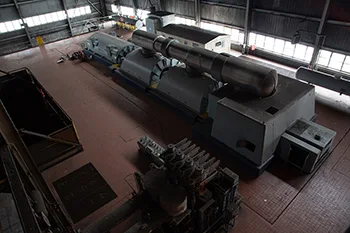
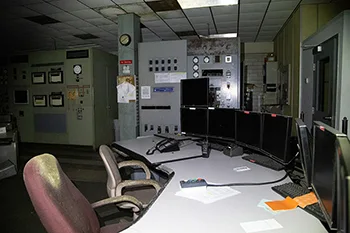 The story of PP#7 resembles most: It was erected in the middle of the last century and closed recently. It produced many hundreds of Megawatts but was ultimately shut down due to increasingly strict pollution regulations. Not much to say really. On paper it's just another power plant. But what we found here is a sprawling, massive conglomeration of raunchy industrial goodness from which it seems like everyone just got up and walked away one day. And one day is about how long it takes to go through everything here; We ran out of daylight on the first trip and had to come back to finish it off properly.
The story of PP#7 resembles most: It was erected in the middle of the last century and closed recently. It produced many hundreds of Megawatts but was ultimately shut down due to increasingly strict pollution regulations. Not much to say really. On paper it's just another power plant. But what we found here is a sprawling, massive conglomeration of raunchy industrial goodness from which it seems like everyone just got up and walked away one day. And one day is about how long it takes to go through everything here; We ran out of daylight on the first trip and had to come back to finish it off properly.
Power Plant #9
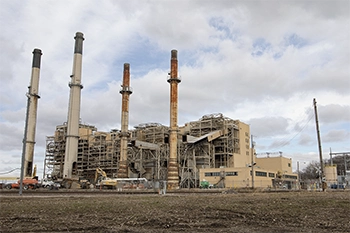
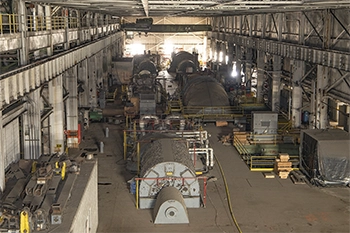 Power Plant #9 was built in 1950 at the cost of $26,000,000. It came online in 1953 with a single 110,000kw turbo-generator which ran on 1250 psi of steam at 950°F. The plant was continuously expanded throughout its life, at the end of which it had a total of four generating units with an output of over 900MW of electricity. It was decommissioned in 2022 and demolished in 2025.
Power Plant #9 was built in 1950 at the cost of $26,000,000. It came online in 1953 with a single 110,000kw turbo-generator which ran on 1250 psi of steam at 950°F. The plant was continuously expanded throughout its life, at the end of which it had a total of four generating units with an output of over 900MW of electricity. It was decommissioned in 2022 and demolished in 2025.
Sayreville Power Plant
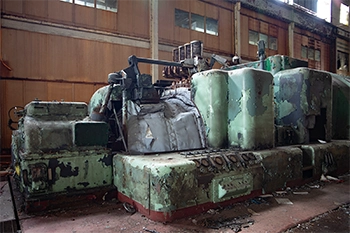
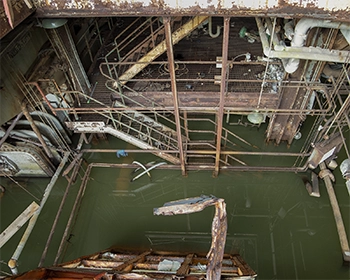 Sayreville Generating Station was constructed in 1930. It came online in October 1930 with two 30,000-kw units with a planned expansion to 180,000-kw generation. The original turbines operated at 450psi and 700°F. Its building expansion was completed in 1942, but installation of the generators and associated equipment was interrupted by the United States' entrance into WWII. This expansion eventually came and brought the plant's maximum capacity up to 100,000-kw. In 1955, it received an expansion for an additional 125,000-kw, increasing the maximum steam pressure to over 2,000psi at 1,050°F at the cost of $25,000,000.
Sayreville Generating Station was constructed in 1930. It came online in October 1930 with two 30,000-kw units with a planned expansion to 180,000-kw generation. The original turbines operated at 450psi and 700°F. Its building expansion was completed in 1942, but installation of the generators and associated equipment was interrupted by the United States' entrance into WWII. This expansion eventually came and brought the plant's maximum capacity up to 100,000-kw. In 1955, it received an expansion for an additional 125,000-kw, increasing the maximum steam pressure to over 2,000psi at 1,050°F at the cost of $25,000,000.
Power Plant #11
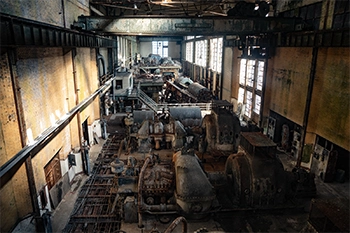
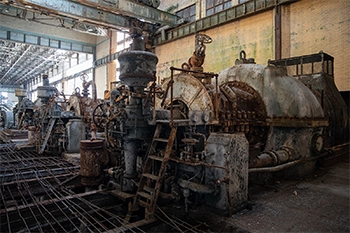 Power Plant #11 was originally constructed in 1914. The plans at the time called for the installation of two comparatiely small 3,500kva three-phase turbogenerators to start out with, but with sufficient additional infrastructure constructed onsite to permit an ultimate capacity of 100,000kw. It would eventually surpass that capacity, but by 1931, it was still only about a third of the way there as it was running three 13,000kw Westinghouse units (installed in 1914, 1918 and 1922, respectively). The 1931 addition consisted of a new 18,000kw 3,600rpm Westinghouse unit which brought the total capacity up to about 55,000kw. But even with the newest unit, the plant itself was comparatively obsolete by this point. In 1939, a massive $23 Million expansion program was undertaken in which the first of several state of the art 100,000+kw generating units were to be installed, one right after the other. The plant was retired in the early 2000's.
Power Plant #11 was originally constructed in 1914. The plans at the time called for the installation of two comparatiely small 3,500kva three-phase turbogenerators to start out with, but with sufficient additional infrastructure constructed onsite to permit an ultimate capacity of 100,000kw. It would eventually surpass that capacity, but by 1931, it was still only about a third of the way there as it was running three 13,000kw Westinghouse units (installed in 1914, 1918 and 1922, respectively). The 1931 addition consisted of a new 18,000kw 3,600rpm Westinghouse unit which brought the total capacity up to about 55,000kw. But even with the newest unit, the plant itself was comparatively obsolete by this point. In 1939, a massive $23 Million expansion program was undertaken in which the first of several state of the art 100,000+kw generating units were to be installed, one right after the other. The plant was retired in the early 2000's.
Richmond Generating Station
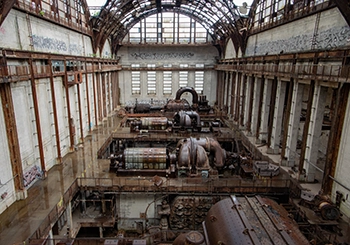
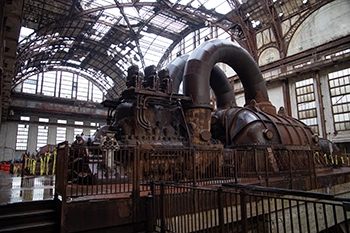 Richmond Generating Station was built in 1925 in Philadelphia Pennsylvania along the Delaware River by the Philadelphia Electric Company. As originally designed, the current plant was intended to be number one of three identical facilities constructed together, in phases, as one single and absolutely gigantic power plant. Richmond Generating Station was designed to be an engineering marvel; simultaneously the most technologically advanced and architecturally stunning power plant in existence, in addition to being the largest power plant in the world. To this end, in 1923, company engineers visited a number of the most modern plants across Europe and the United States. The result of their studies formed the basis of ten different initial plant designs based on the information gathered on their research trips. The final design was intended to be 3 functionally independent facilities, the purpose of which was to increase safety to a degree not possible if all of the units were housed in a single building, and to increase reliability to a degree that significant technical issues in one plant would not spill over to take the entire site offline. Furthermore, by building in phases, any new advances in technology could be adapted and deployed within each subsequent installation. Lastly, light and ventilation was found to be more efficiently utilized by the installation of three smaller plants versus one large plant. The plant in its final form was designed by chief engineer Dr William C. L. Eglin and the architect who designed the building was John Torrey Windrim. It was constructed by Stone and Webster Inc using 8,000 tons of cutting-edge silicon steel, plus 3 tons of regular carbon steel, furnished by the American Bridge Company. Construction of the plant was supervised by Alexander Wilson III. Construction began on April 25, 1924.
Richmond Generating Station was built in 1925 in Philadelphia Pennsylvania along the Delaware River by the Philadelphia Electric Company. As originally designed, the current plant was intended to be number one of three identical facilities constructed together, in phases, as one single and absolutely gigantic power plant. Richmond Generating Station was designed to be an engineering marvel; simultaneously the most technologically advanced and architecturally stunning power plant in existence, in addition to being the largest power plant in the world. To this end, in 1923, company engineers visited a number of the most modern plants across Europe and the United States. The result of their studies formed the basis of ten different initial plant designs based on the information gathered on their research trips. The final design was intended to be 3 functionally independent facilities, the purpose of which was to increase safety to a degree not possible if all of the units were housed in a single building, and to increase reliability to a degree that significant technical issues in one plant would not spill over to take the entire site offline. Furthermore, by building in phases, any new advances in technology could be adapted and deployed within each subsequent installation. Lastly, light and ventilation was found to be more efficiently utilized by the installation of three smaller plants versus one large plant. The plant in its final form was designed by chief engineer Dr William C. L. Eglin and the architect who designed the building was John Torrey Windrim. It was constructed by Stone and Webster Inc using 8,000 tons of cutting-edge silicon steel, plus 3 tons of regular carbon steel, furnished by the American Bridge Company. Construction of the plant was supervised by Alexander Wilson III. Construction began on April 25, 1924.
The Waterworks
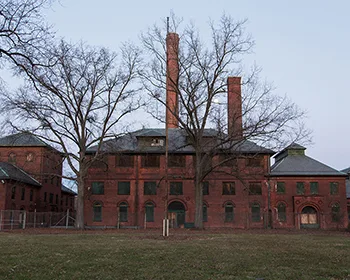
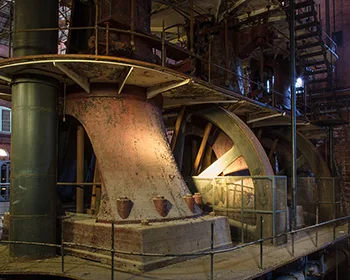 The Waterworks was constructed in the early 1880's on a small man-made island in the middle of a river. When The Waterworks came online, it provided clean drinking water at a rate of 3.8 Million gallons per day. The population of the surrounding neighborhoods expanded quickly, however, in the years following the Civil War and with it came an increased demand for water. In 1886, a new engine was installed, capable of delivering 10 Million gallons per day. In the early 1900's, The Waterworks was working on new water filtration techniques and built a large new filtration plant and laboratory on site. Demand for clean water continued to increase, so in 1911, the waterworks installed the massive 5 story Allis Chalmers steam engine you see here which by itself had a capacity of 20 Million gallons per day. This steam engine stands 50 feet tall and each of its 32-ton flywheels can push 607 gallons of water with each revolution.
The Waterworks was constructed in the early 1880's on a small man-made island in the middle of a river. When The Waterworks came online, it provided clean drinking water at a rate of 3.8 Million gallons per day. The population of the surrounding neighborhoods expanded quickly, however, in the years following the Civil War and with it came an increased demand for water. In 1886, a new engine was installed, capable of delivering 10 Million gallons per day. In the early 1900's, The Waterworks was working on new water filtration techniques and built a large new filtration plant and laboratory on site. Demand for clean water continued to increase, so in 1911, the waterworks installed the massive 5 story Allis Chalmers steam engine you see here which by itself had a capacity of 20 Million gallons per day. This steam engine stands 50 feet tall and each of its 32-ton flywheels can push 607 gallons of water with each revolution.
Water Treatment Plant
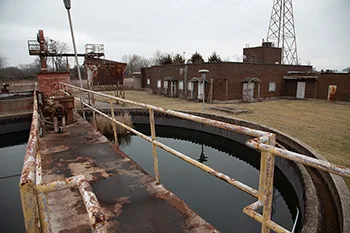
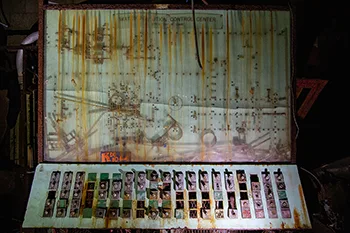 This water treatment plant is located in East Saint Louis, Illinois. I can't find any history on this place to indicate when it was constructed or how long it remained in operation but I'd estimate it ran from the mid 1950's to mid 90's. The central piece of machinery found here is the set of Komline Sanderson rotary drum filters.
This water treatment plant is located in East Saint Louis, Illinois. I can't find any history on this place to indicate when it was constructed or how long it remained in operation but I'd estimate it ran from the mid 1950's to mid 90's. The central piece of machinery found here is the set of Komline Sanderson rotary drum filters.
The Chemical Plant
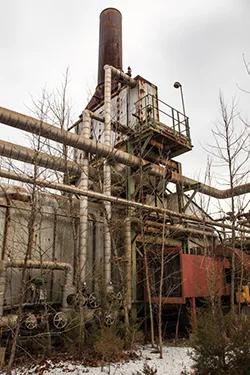
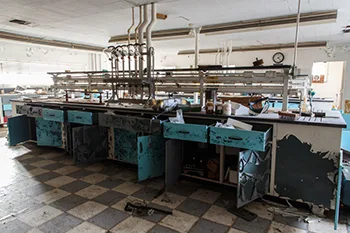 The Chemical Plant was constructed in the 1960s as one branch of the chemical division of a larger manufacturing company, which had been in operation for over 100 years. In the mid 1980s, this chemical division was incorporated as its own separate company. The newly formed company, however, would not last two decades before declaring bankruptcy. Shortly thereafter, it was bought out by a competitor. This plant, having been in violation of safety codes by this time, was shut down.
The Chemical Plant was constructed in the 1960s as one branch of the chemical division of a larger manufacturing company, which had been in operation for over 100 years. In the mid 1980s, this chemical division was incorporated as its own separate company. The newly formed company, however, would not last two decades before declaring bankruptcy. Shortly thereafter, it was bought out by a competitor. This plant, having been in violation of safety codes by this time, was shut down.
Gasometer Pumping Station N
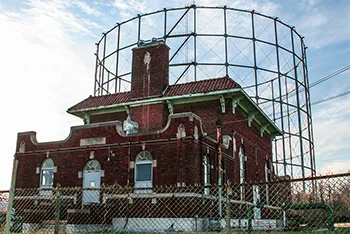
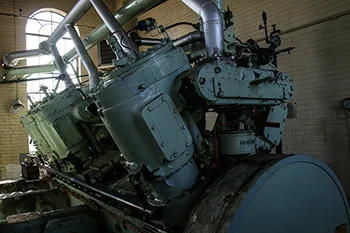 This gasometer (Laclede Gas Company Pumping Station N) was an above ground natural gas storage facility. It's been out of service for a few years but overall everything was in pretty good shape. Climbing to the top of the dome, you could clearly smell gas and the closer you got to the top, you could hear a whistling noise as natural gas was rushing out of the hole in the top. Eh, that's probably ok.
This gasometer (Laclede Gas Company Pumping Station N) was an above ground natural gas storage facility. It's been out of service for a few years but overall everything was in pretty good shape. Climbing to the top of the dome, you could clearly smell gas and the closer you got to the top, you could hear a whistling noise as natural gas was rushing out of the hole in the top. Eh, that's probably ok.
Thomas Edison Laboratory
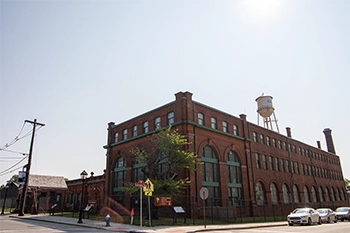
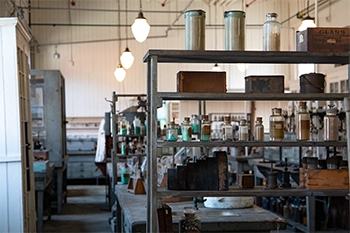 The Thomas Edison Laboratory in West Orange, New Jersey was built in 1887 and from thence it spawned the motion picture camera (and, subsequently, the movies which they produced), sound recordings and the nickel-iron alkaline battery among other things. The single most important invention developed here was the first ever cat video featuring a cat boxing match which was captured in 1894. A truly remarkable achievement. The site today is preserved as a National Park and it is an incredible time-capsule of turn-of-the-century industrial engineering. It was basically preserved in place exactly as it was left when Thomas Edison died in 1931.
The Thomas Edison Laboratory in West Orange, New Jersey was built in 1887 and from thence it spawned the motion picture camera (and, subsequently, the movies which they produced), sound recordings and the nickel-iron alkaline battery among other things. The single most important invention developed here was the first ever cat video featuring a cat boxing match which was captured in 1894. A truly remarkable achievement. The site today is preserved as a National Park and it is an incredible time-capsule of turn-of-the-century industrial engineering. It was basically preserved in place exactly as it was left when Thomas Edison died in 1931.
Eureka Springs and North Arkansas Railway
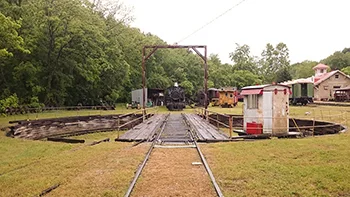
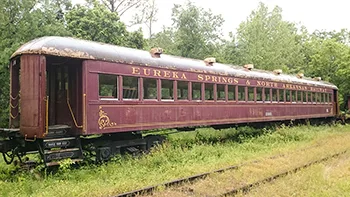 Located in Eureka Springs, Arkansas, the Eureka Springs and North Arkansas Railway is a working museum located at the site of the town's fully restored railroad depot which was built in 1913 and appears to be appropriately furnished inside, though it was closed on the day I visited. This museum is home to a collection of vintage train cars and other relics including steam locomotives, compressors, pumps and engines. During the summer, you can book a ride on one of the cars pulled by a more modern diesel locomotive. There's also an old locomotive turn-table which they evidently still operate from time to time, despite its rather unstable appearance. One of the more prominent trains on site include the old No. 201, a 2-6-0 (Mogul) built in 1906 by the American Locomotive Company in Patterson New Jersey as a coal burner and was later converted to oil. It is one of only three known surviving locomotives to have worked on the Panama Canal. Attached to this machine is an old caged circus car, complete with an animal doghouse style enclosure inside. There's also an interesting 1951 Chevrolet converted to use as a track inspector's car, among other things.
Located in Eureka Springs, Arkansas, the Eureka Springs and North Arkansas Railway is a working museum located at the site of the town's fully restored railroad depot which was built in 1913 and appears to be appropriately furnished inside, though it was closed on the day I visited. This museum is home to a collection of vintage train cars and other relics including steam locomotives, compressors, pumps and engines. During the summer, you can book a ride on one of the cars pulled by a more modern diesel locomotive. There's also an old locomotive turn-table which they evidently still operate from time to time, despite its rather unstable appearance. One of the more prominent trains on site include the old No. 201, a 2-6-0 (Mogul) built in 1906 by the American Locomotive Company in Patterson New Jersey as a coal burner and was later converted to oil. It is one of only three known surviving locomotives to have worked on the Panama Canal. Attached to this machine is an old caged circus car, complete with an animal doghouse style enclosure inside. There's also an interesting 1951 Chevrolet converted to use as a track inspector's car, among other things.
Como Roundhouse
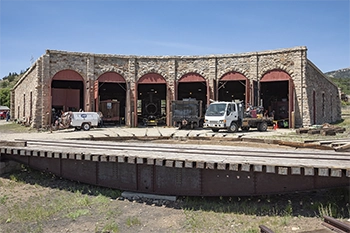
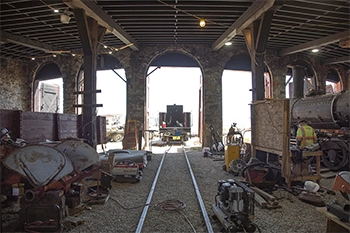 The Como Roundhouse was built by Italian stonemasons in Como, Colorado, in 1881. It is said to be the oldest operating roundhouse in the United States. It originally had 6 stalls but by 1900, a wooden addition (which no longer exists) brought the total number of stalls up to 19. In addition to the roundhouse, the site also includes the associated Train Depot and Como Hotel. The Como Train Depot was built in 1879 and the first train arrived on June 21st of that year. The current hotel was built in 1897 after the original one burned down and the more plain structure, built on the original foundation, replaced it. Train service to Como ceased in 1939 after which the roundhouse, depot and hotel were abandoned. By the 1970s, the entire site was ruinous and would likely not exist today if not for the work of various individuals and groups over the years who have poured their own time and money into restoration efforts. All work is done by passionate volunteers who work tirelessly to preserve and honor the history of the area. It is the opinion of this author that these volunteers are not only doing great work, but they are living out the wildest dreams which lie just under the surface of every man; they are directly restoring/repairing/rebuilding a unique historic site which includes but is not limited to old locomotives and related machinery. Hell yes. Speaking of which, the roundhouse obtained a Baldwin steam locomotive some time ago. Her name is Klondike Kate and she had been abandoned and rusting away in a field in Oklahoma before being brought to Como where she was operational for some time until a recent piston failure took her out of commission. Klondike Kate is currently being rebuilt in the shops at Como. As if that's not enough, there's even a handcar which you can drive a short distance and back down the tracks. The massive turntable is one of the more obvious examples of the restoration work done here; a few years ago it was dismantled and the pit was filed with debris. Now, it can be effortlessly rotated by hand as it spins around smoothly on rebuilt bearings.
The Como Roundhouse was built by Italian stonemasons in Como, Colorado, in 1881. It is said to be the oldest operating roundhouse in the United States. It originally had 6 stalls but by 1900, a wooden addition (which no longer exists) brought the total number of stalls up to 19. In addition to the roundhouse, the site also includes the associated Train Depot and Como Hotel. The Como Train Depot was built in 1879 and the first train arrived on June 21st of that year. The current hotel was built in 1897 after the original one burned down and the more plain structure, built on the original foundation, replaced it. Train service to Como ceased in 1939 after which the roundhouse, depot and hotel were abandoned. By the 1970s, the entire site was ruinous and would likely not exist today if not for the work of various individuals and groups over the years who have poured their own time and money into restoration efforts. All work is done by passionate volunteers who work tirelessly to preserve and honor the history of the area. It is the opinion of this author that these volunteers are not only doing great work, but they are living out the wildest dreams which lie just under the surface of every man; they are directly restoring/repairing/rebuilding a unique historic site which includes but is not limited to old locomotives and related machinery. Hell yes. Speaking of which, the roundhouse obtained a Baldwin steam locomotive some time ago. Her name is Klondike Kate and she had been abandoned and rusting away in a field in Oklahoma before being brought to Como where she was operational for some time until a recent piston failure took her out of commission. Klondike Kate is currently being rebuilt in the shops at Como. As if that's not enough, there's even a handcar which you can drive a short distance and back down the tracks. The massive turntable is one of the more obvious examples of the restoration work done here; a few years ago it was dismantled and the pit was filed with debris. Now, it can be effortlessly rotated by hand as it spins around smoothly on rebuilt bearings.
Nickel Plate Roundhouse
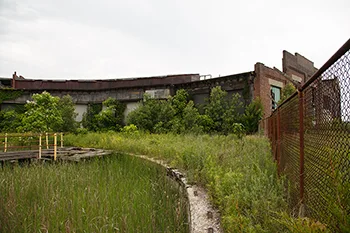
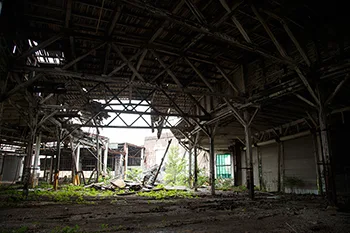 This site started out in the 1870's as a locomotive repair shop for the Clover Leaf District of the Nickel Plate Railroad (which was formed through a merger of the New York, Chicago and St. Louis Railroad). The roundhouse and turntable were added in the early 1920's. "The Nickel Plate Road was one of the last major steam railroads to switch to the new diesel-electric locomotives. One reason for this was the famed 'Berkshires' a 2-8-4 wheel arrangement steam locomotive capable of pulling heavy freight trains at high speed. In the early 1950s, the Nickel Plate took a look at the diesels and decided to stick with the Berkshires."(3) Nickle Plate, with other mid-western railroads, eventually merged with Norfolk Southern in 1964 but the roundhouse here continued to service locomotives and rail cars through the 1970's. These buildings eventually fell into disuse and after 40 years the structure is unfortunately experiencing demolition through neglect and as of the time of this trip, most of the roof has collapsed.
This site started out in the 1870's as a locomotive repair shop for the Clover Leaf District of the Nickel Plate Railroad (which was formed through a merger of the New York, Chicago and St. Louis Railroad). The roundhouse and turntable were added in the early 1920's. "The Nickel Plate Road was one of the last major steam railroads to switch to the new diesel-electric locomotives. One reason for this was the famed 'Berkshires' a 2-8-4 wheel arrangement steam locomotive capable of pulling heavy freight trains at high speed. In the early 1950s, the Nickel Plate took a look at the diesels and decided to stick with the Berkshires."(3) Nickle Plate, with other mid-western railroads, eventually merged with Norfolk Southern in 1964 but the roundhouse here continued to service locomotives and rail cars through the 1970's. These buildings eventually fell into disuse and after 40 years the structure is unfortunately experiencing demolition through neglect and as of the time of this trip, most of the roof has collapsed.
Central Railroad Terminal of New Jersey
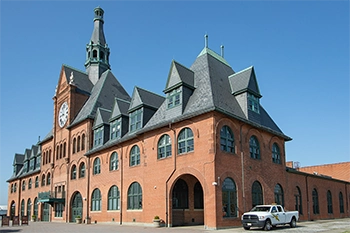
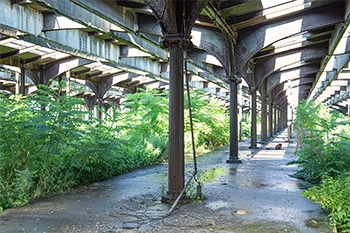 The Central Railroad Terminal of New Jersey was constructed in 1889 and was the main passenger terminal for the Central Railroad Company. A large train shed and concourse was added to the rear of the terminal in 1912-1914. At its peak in 1929, more than 65,000 people and 350 trains passed through the terminal in a single day. As was the case elsewhere throughout the United States in the mid 20th century, train ridership dwindled as a result of increased use of the automobile. On April 30, 1967, the New Jersey Central Terminal ceased passenger operations. The terminal was left abandoned for about a decade before restoration work began in the late 1970s. It is now administered by the Division of Parks and Forestry and it is currently a hub for boat tours of the New York area.
The Central Railroad Terminal of New Jersey was constructed in 1889 and was the main passenger terminal for the Central Railroad Company. A large train shed and concourse was added to the rear of the terminal in 1912-1914. At its peak in 1929, more than 65,000 people and 350 trains passed through the terminal in a single day. As was the case elsewhere throughout the United States in the mid 20th century, train ridership dwindled as a result of increased use of the automobile. On April 30, 1967, the New Jersey Central Terminal ceased passenger operations. The terminal was left abandoned for about a decade before restoration work began in the late 1970s. It is now administered by the Division of Parks and Forestry and it is currently a hub for boat tours of the New York area.
Terminus
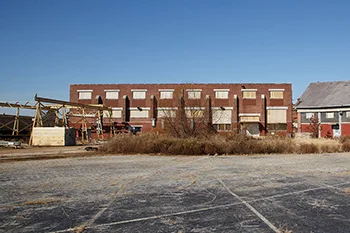
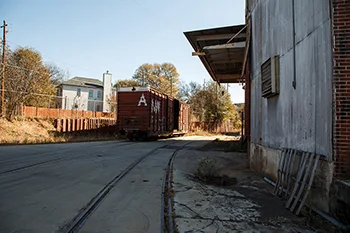 When we started this road trip there were 4 of us. But 4 didn't return. You see, the road to Terminus was very long and treacherous. By the time we thought we were close, our rations were almost gone and I couldn't get comfortable in a new place on an empty stomach. Sure, I had a couple of Lunchables left in my bag along with some Capri Suns but I just couldn't eat another one of those cold lifeless meals. A decision was made. And before I knew it, I was drizzling Stubb's BBQ sauce on the second helping of my good comrades well-done forearm. RIP. You were delicious, friend. Thanks to his sacrifice, we had enough strength left for the last 20 yards or so. It wasn't difficult to find, we just followed the signs: "'TERMINUS' Sanctuary for all. Community for all. Those who arrive, survive." But when we arrived, it was a ghost town. There was no-one in sight. No sanctuary here. I sat down to weep as I ate my second to last "Extra Cheesy Pizza" Lunchable -our late comrade's fingernails still caught in my teeth.
When we started this road trip there were 4 of us. But 4 didn't return. You see, the road to Terminus was very long and treacherous. By the time we thought we were close, our rations were almost gone and I couldn't get comfortable in a new place on an empty stomach. Sure, I had a couple of Lunchables left in my bag along with some Capri Suns but I just couldn't eat another one of those cold lifeless meals. A decision was made. And before I knew it, I was drizzling Stubb's BBQ sauce on the second helping of my good comrades well-done forearm. RIP. You were delicious, friend. Thanks to his sacrifice, we had enough strength left for the last 20 yards or so. It wasn't difficult to find, we just followed the signs: "'TERMINUS' Sanctuary for all. Community for all. Those who arrive, survive." But when we arrived, it was a ghost town. There was no-one in sight. No sanctuary here. I sat down to weep as I ate my second to last "Extra Cheesy Pizza" Lunchable -our late comrade's fingernails still caught in my teeth.
Cottonbelt Freight Depot
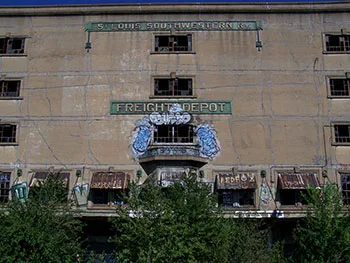
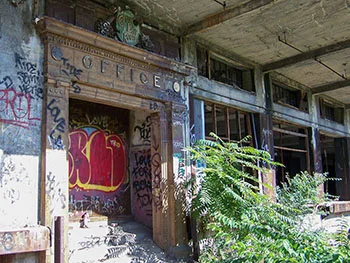 The Cottonbelt Freight Depot, also known as St. Louis Southwestern Railroad Freight Depot, was built in 1911 and opened in 1913. The Cotton Belt was a valuable trade route that extended from Saint Louis to Texas. By the 1920's, the Cotton Belt was a success and many upgrades were being done to the lines to ensure future successes. But by 1924, the automobile was overtaking rail as the main source of transportation. Passenger service ceased in 1959. The building was vacant by 1989.
The Cottonbelt Freight Depot, also known as St. Louis Southwestern Railroad Freight Depot, was built in 1911 and opened in 1913. The Cotton Belt was a valuable trade route that extended from Saint Louis to Texas. By the 1920's, the Cotton Belt was a success and many upgrades were being done to the lines to ensure future successes. But by 1924, the automobile was overtaking rail as the main source of transportation. Passenger service ceased in 1959. The building was vacant by 1989.
Armour Meat Packing Plant
The Armour Meat Packing Plant in East Saint Louis was constructed in 1903 and it closed in 1959. It was used to some capacity for a decade or two after the Armour Meat company left, but for all the subsequent years since, this industrial relic whose massive De La Vergne Double-Acting Refrigerating Machine (of which there are surely very few left in the world) and other assorted compressors and antique machinery stood here mostly undisturbed. The Double-Acting machine was a new technology in the late 1800's which produced compression on both strokes of the piston and this doubled the machine's capacity without changing its size footprint. The site had become something like an Industrial Revolution era museum slowly being overtaken by nature. Rarely do things like this last as long as it had here. This is what made Armour one of the most interesting locations I've had the opportunity to visit and I did so many times over the years. There is basically nowhere else like this left anywhere.
Weirton Steel Works
Weirton Steel was constructed in the early 1900's and quickly became one of the largest such steel facilities in the world. During WWII, this facility was quickly converted, months ahead of schedule, to the production of wartime munitions and set numerous records for their enormous output of the various types of metals produced here which were of the highest quality. The blast furnaces, whose temperatures reached 3,000 degrees or more, and of which there were several here, each produced thousands of tons of metal per day. They conveyed the molten metal through channels dug into the floor to train cars which had a capacity of 100 tons each.
Sloss Furnaces
Sloss Furnaces was founded in Birmingham Alabama in 1880 by one of the founders of Birmingham itself, Colonel James Withers Sloss. The Furnaces began operating in 1882 as a "pig iron" blast furnace and was the first blast furnace in Birmingham. In its first year it produced 24,000 tons of high quality iron. James Sloss retired in 1886 and sold the company.
The Lemp Brewery
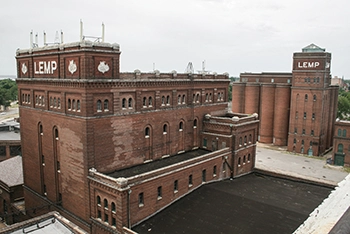
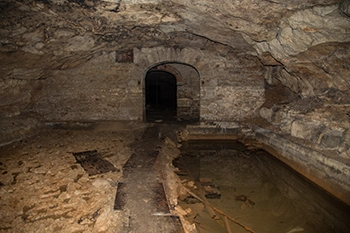 The Lemp Brewing Company was founded as the Western Brewery by Adam Lemp in 1840 in Saint Louis, Missouri. Adam Lemp initially started out as a grocer but quickly moved into the brewery and saloon business which proved to be more popular. The Western Brewery was originally located on Second Street (between Walnut and Elm) where its annual output was initialy around 100 barrels. Within ten years, the brewery had 6 employees with an output of 4,000 barrels and that number would be more than doubled, to 8,300, another 10 years later [40]. By the time prohibition descended upon the enterprise 80 years after it had first begun, the Lemp Brewing Company had established world-renown and was one of the largest breweries in the world with an annual output which exceeded 500,000 barrels [16]. A major contributing factor to this success was the leadership of the brewery throughout its history who proved to be relentless and innovative in the art of operational logistics as well as in the art of brewing; they had developed an unrivaled global distribution network which enabled them to cement the Lemp reputation far beyond the reach of most competitors. By 1891 [15], all shipments from the brewery to destinations outside of Saint Louis began their journey on Lemp's own Western Cable Railway which was an engineering solution that connected the brewery itself to a rail yard located 2000 feet down a steep hill from the plant.
The Lemp Brewing Company was founded as the Western Brewery by Adam Lemp in 1840 in Saint Louis, Missouri. Adam Lemp initially started out as a grocer but quickly moved into the brewery and saloon business which proved to be more popular. The Western Brewery was originally located on Second Street (between Walnut and Elm) where its annual output was initialy around 100 barrels. Within ten years, the brewery had 6 employees with an output of 4,000 barrels and that number would be more than doubled, to 8,300, another 10 years later [40]. By the time prohibition descended upon the enterprise 80 years after it had first begun, the Lemp Brewing Company had established world-renown and was one of the largest breweries in the world with an annual output which exceeded 500,000 barrels [16]. A major contributing factor to this success was the leadership of the brewery throughout its history who proved to be relentless and innovative in the art of operational logistics as well as in the art of brewing; they had developed an unrivaled global distribution network which enabled them to cement the Lemp reputation far beyond the reach of most competitors. By 1891 [15], all shipments from the brewery to destinations outside of Saint Louis began their journey on Lemp's own Western Cable Railway which was an engineering solution that connected the brewery itself to a rail yard located 2000 feet down a steep hill from the plant.
Falstaff Brewery #10
This location was originally Wm. Stumpf's Brewery and was constructed in 1853. Stumpf remained throughout various partnerships and acquisitions until 1877 when the short-lived Thamer Brewing Company took over. Two years later, Anton Griesedieck came into the picture, but ownership would revolve around between The Miller Bros, The Saint Louis Brewing Association and the Consumers Brewing Company before finally returning to the Griesedieck Bros. In 1920, Joseph Griesedieck approached his good friend...
The Old Crow Distillery
Old Crow was founded in the early 1800's. It was was eventually abandoned in the 1980s, though it was likely not in use for some time before that. It borders an active distillery, the one that bought it out, and is therefore very difficult to access.
The Tube Factory
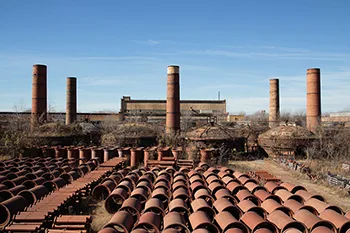
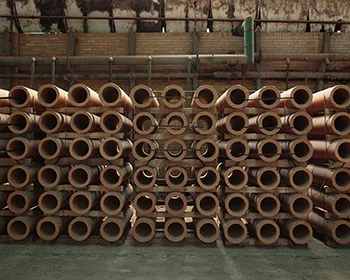 The Tube Factory, AKA Mission Clay, AKA Pittsburg Sewer Pipe & Conduit Co. AKA Pittsburg Paving Brick Company AKA Dickey Clay, was constructed in 1899 in Pittsburg Kansas. They produced many types of tubes. Bendy tubes, girthy tubes, long skinny tubes and even square and octagonal tubes. Many miles of sewer tunnels were actually born right here.
The Tube Factory, AKA Mission Clay, AKA Pittsburg Sewer Pipe & Conduit Co. AKA Pittsburg Paving Brick Company AKA Dickey Clay, was constructed in 1899 in Pittsburg Kansas. They produced many types of tubes. Bendy tubes, girthy tubes, long skinny tubes and even square and octagonal tubes. Many miles of sewer tunnels were actually born right here.
Industrial Site #2
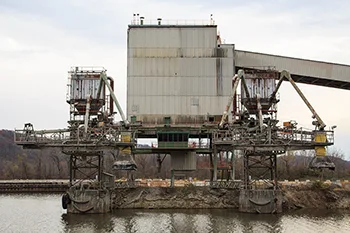
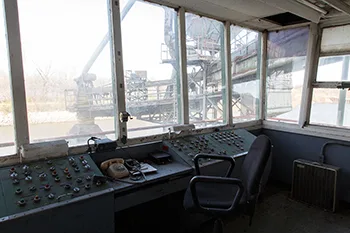 This facility was constructed in the late 1960s and was the largest employer in the area up until it was closed about 5 years ago, terminating nearly 200 jobs.
This facility was constructed in the late 1960s and was the largest employer in the area up until it was closed about 5 years ago, terminating nearly 200 jobs.
Factory #8
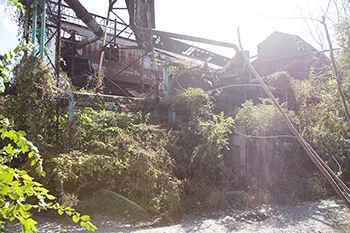
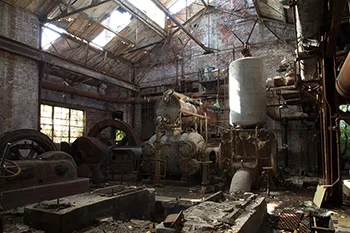 Factory #8 was founded in 1901 and quickly became an indispensable manufacturer of railroad and train products. By the 1920's, its two largest customers merged and acquired Factory #8 in the process. At this point nearly all trains in the United States were built using products from this very manufacturing plant.
This plant was run by the same owners until the 1970's when it was sold to a local competitor and closed down not long thereafter. It was then sold to a smaller local company who demolished much of the disused manufacturing space and continues to operate out of the remaining buildings to this day.
Factory #8 was founded in 1901 and quickly became an indispensable manufacturer of railroad and train products. By the 1920's, its two largest customers merged and acquired Factory #8 in the process. At this point nearly all trains in the United States were built using products from this very manufacturing plant.
This plant was run by the same owners until the 1970's when it was sold to a local competitor and closed down not long thereafter. It was then sold to a smaller local company who demolished much of the disused manufacturing space and continues to operate out of the remaining buildings to this day.
Cementland Saint Louis
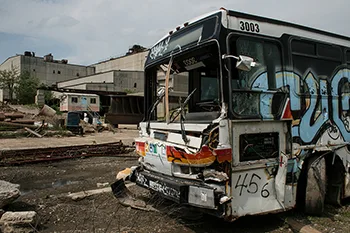
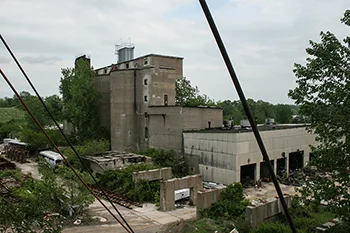 This site was Lafarge Cement Plant until it closed down. Eventually, the owner of Saint Louis City Museum bought it and is currently transforming it into Cementland.
This site was Lafarge Cement Plant until it closed down. Eventually, the owner of Saint Louis City Museum bought it and is currently transforming it into Cementland.
Cementland Part 2
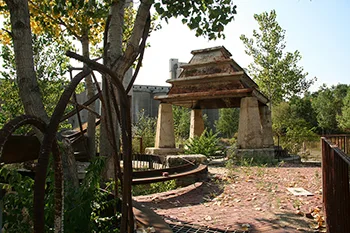
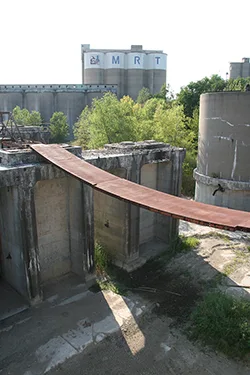 Cementland was set to become the next great Saint Louis landmark. The product of the late Bob Cassily, it was almost too big and too awesome to ever exist. If completed, it was to even include a water-park snaking through its industrial ruins and post apocalyptic landscape. Cementland was the site of the former Lafarge Cement plant. Left abandoned, Bob saw the potential and made significant headway in creating one of the largest and most impressive interactive exhibits. By utilizing leftovers from demolished buildings and large broken industrial equipment and basically anything else he could get his hands on, he set out to create something from the otherwise wasted resources. Bob Cassily is the type of creative genius that doesn't happen very often. He is the type of person every city needs to have. He became famous for the wildly successful City Museum. The Saint Louis City Museum is something that must be experienced to be believed. Any visit to Saint Louis would not be complete without a trip to City Museum. If you haven't been, do yourself a favor and go explore it. Also, the roof is worth paying extra for. Bob died on September 26th, 2011, when the bulldozer he was driving flipped down a hill while working on Cementland. His death is a loss that Saint Louis may never recover from and the impact he's had will be forever engrained into the Saint Louis experience. Our visit to Cementland was a celebration of his accomplishment and an homage to the very site he d
Cementland was set to become the next great Saint Louis landmark. The product of the late Bob Cassily, it was almost too big and too awesome to ever exist. If completed, it was to even include a water-park snaking through its industrial ruins and post apocalyptic landscape. Cementland was the site of the former Lafarge Cement plant. Left abandoned, Bob saw the potential and made significant headway in creating one of the largest and most impressive interactive exhibits. By utilizing leftovers from demolished buildings and large broken industrial equipment and basically anything else he could get his hands on, he set out to create something from the otherwise wasted resources. Bob Cassily is the type of creative genius that doesn't happen very often. He is the type of person every city needs to have. He became famous for the wildly successful City Museum. The Saint Louis City Museum is something that must be experienced to be believed. Any visit to Saint Louis would not be complete without a trip to City Museum. If you haven't been, do yourself a favor and go explore it. Also, the roof is worth paying extra for. Bob died on September 26th, 2011, when the bulldozer he was driving flipped down a hill while working on Cementland. His death is a loss that Saint Louis may never recover from and the impact he's had will be forever engrained into the Saint Louis experience. Our visit to Cementland was a celebration of his accomplishment and an homage to the very site he d
The Aluminum Foundry
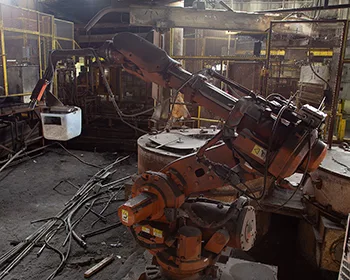
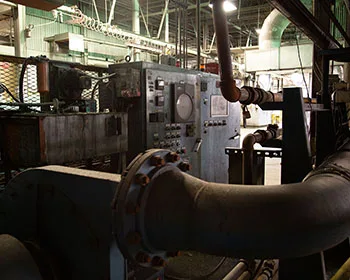 This Aluminum Foundry was constructed in 1970 and closed down in 2018. Shortly before it was demolished we found ourselves inside and had the opportunity to inspect their kickass robots in person.
I was aware of this site while it was still fully operational but I had a feeling it would close down sooner than later. So I kept my eye on it and drove by every so often just in case. Eventually closure was announced, people came and went, the big sign out front was removed and things got interesting.
This Aluminum Foundry was constructed in 1970 and closed down in 2018. Shortly before it was demolished we found ourselves inside and had the opportunity to inspect their kickass robots in person.
I was aware of this site while it was still fully operational but I had a feeling it would close down sooner than later. So I kept my eye on it and drove by every so often just in case. Eventually closure was announced, people came and went, the big sign out front was removed and things got interesting.
Foundry #4
Foundry #4 is, as far as I can tell, the oldest factory from this company still standing. The company itself was formed in the 1820's and, after achieving great success with some of its early products, quickly rose to prominence as a premier manufacturer with locations across the globe. The company is well known for its many varieties of products which found their way into "most" heavy machinery in use in the United States at the turn of the century. The company was also directly responsible for the increased adoption and use of electricity, particularly in regard to smaller electric plants in rural areas, along with many other notable contributions to the Industrial Revolution.
Century Electric Foundry - AKA - City Foundry STL
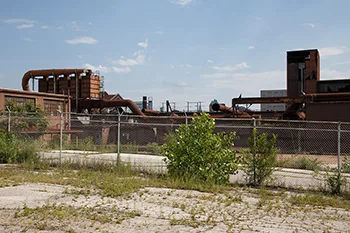
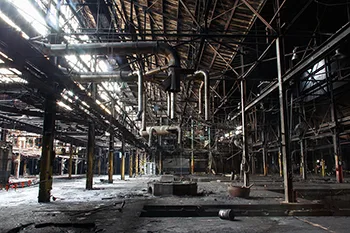 Century Electric Foundry was constructed in Saint Louis in 1929 and was employed in the production of a variety of hardware from electric motors and generators to auto parts. The company was based in Saint Louis and were one of the largest such manufacturers in the nation. Their motors ranged from small fractional horsepower types used in small appliances all the way up to industrial strength versions capable of powering an entire factory. Century Electric started out as the H.E. Lindsey Electrical Supply Company on July 1, 1900 but that only lasted until 1903 when Lindsey left and the company reorganized. During the initial years, they operated out of a former church and could only produce one motor at a time but soon expanded to the point they were exporting their products to over 90 foreign countries. In 1914, they devised a new form of small repulsion type electric motor which almost single-handedly caused a revolution paving the way for early household appliances. The first successful electric home refrigerator had a Century motor inside. Frigidaire became a major customer having purchased a large part of its compressor motors from Century before designing and building their own. They went on to innovate in the area of desktop and ceiling fans and the business quickly outgrew its various smaller office buildings and factory spaces before finally acquiring the land that this foundry sits on today which they acquired from the Lily Busch estate. On April 30, 1930, the foundry commenced its first pour.
Century Electric Foundry was constructed in Saint Louis in 1929 and was employed in the production of a variety of hardware from electric motors and generators to auto parts. The company was based in Saint Louis and were one of the largest such manufacturers in the nation. Their motors ranged from small fractional horsepower types used in small appliances all the way up to industrial strength versions capable of powering an entire factory. Century Electric started out as the H.E. Lindsey Electrical Supply Company on July 1, 1900 but that only lasted until 1903 when Lindsey left and the company reorganized. During the initial years, they operated out of a former church and could only produce one motor at a time but soon expanded to the point they were exporting their products to over 90 foreign countries. In 1914, they devised a new form of small repulsion type electric motor which almost single-handedly caused a revolution paving the way for early household appliances. The first successful electric home refrigerator had a Century motor inside. Frigidaire became a major customer having purchased a large part of its compressor motors from Century before designing and building their own. They went on to innovate in the area of desktop and ceiling fans and the business quickly outgrew its various smaller office buildings and factory spaces before finally acquiring the land that this foundry sits on today which they acquired from the Lily Busch estate. On April 30, 1930, the foundry commenced its first pour.
Metal Foundry
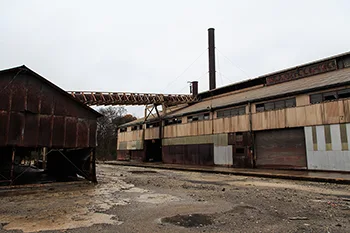
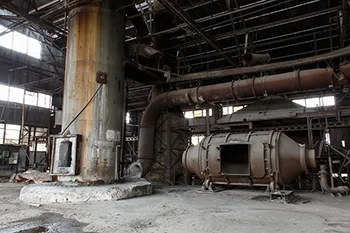 The W.J. Bullock Metal Foundry in Birmingham Alabama produced copper, zinc and aluminum from 1933 until some time within the past few years.
The W.J. Bullock Metal Foundry in Birmingham Alabama produced copper, zinc and aluminum from 1933 until some time within the past few years.
Indianapolis Coke
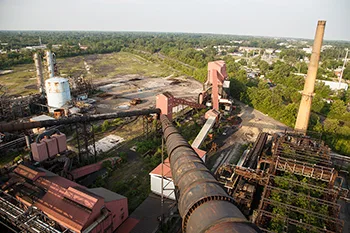
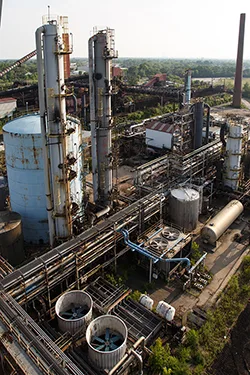 Indianapolis Coke was founded on October 24 1887 as Consumers Gas Trust Company. This company was formed by, among others, city leaders Thomas Morris, Colonel Eli Lilly and Benjamin Harrison as a public charitable trust in an effort to prevent Standard Oil Company from acquiring the franchise over the large natural gas fields recently discovered in parts of Indiana thus giving them a monopoly over all gas in Indianapolis.
But decades before Consumers Gas Trust Company was formed, fierce rivalries had been waging war. Gas entrepreneurs who all vied for the right to provide gas for Indianapolis battled each other over contracts, rates and customers. And before the dust settled, the earth would shake beneath them.
Indianapolis Coke was founded on October 24 1887 as Consumers Gas Trust Company. This company was formed by, among others, city leaders Thomas Morris, Colonel Eli Lilly and Benjamin Harrison as a public charitable trust in an effort to prevent Standard Oil Company from acquiring the franchise over the large natural gas fields recently discovered in parts of Indiana thus giving them a monopoly over all gas in Indianapolis.
But decades before Consumers Gas Trust Company was formed, fierce rivalries had been waging war. Gas entrepreneurs who all vied for the right to provide gas for Indianapolis battled each other over contracts, rates and customers. And before the dust settled, the earth would shake beneath them.
Carondelet Coke Plant
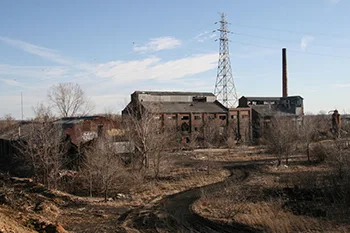
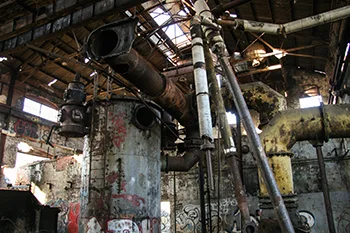 Carondelet Coke started as St Louis Ore and Steel Company in 1870 in the Carondelet neighborhood of Saint Louis, Missouri. It remained in operation until 1896 and sat idle for nearly 20 years before Laclede Gas purchased the property and transformed it into a coke oven and coal gasification plant. After being sold a few times over the years, it was ultimately abandoned in 1987. Before being demolished in 2009, it was a favorite urban exploration and graffiti destination. The site consisted of 11 acres of glorious industrial abandonment.
Carondelet Coke started as St Louis Ore and Steel Company in 1870 in the Carondelet neighborhood of Saint Louis, Missouri. It remained in operation until 1896 and sat idle for nearly 20 years before Laclede Gas purchased the property and transformed it into a coke oven and coal gasification plant. After being sold a few times over the years, it was ultimately abandoned in 1987. Before being demolished in 2009, it was a favorite urban exploration and graffiti destination. The site consisted of 11 acres of glorious industrial abandonment.
Coal Products Incorporated
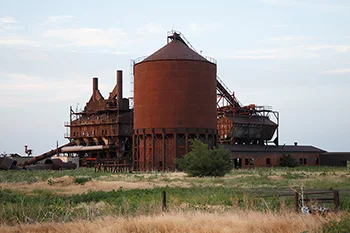
 Gather around my friends and listen to the story which I am about to tell. I was out hiking the mountains with my wife when a storm came out of nowhere. We found a spot and set up the tent and waited for the storm to pass. Day turned into night and the rain only got worse. We slept and in the morning the skies were cleared up. But the sky was different. Everything was different. I began to wonder if we had been poisoned. Before the thought had taken the form of a verbal proposition, we heard footsteps. Loud footsteps. It sounded as if the whole mountain was being smashed down. Trees creaked and snapped, birds screamed and flew off in large numbers. A large shadowy figure loomed towards us and we had no place to run. I thought we were going to die. The massive beast moved in for the kill and finally I could see it but I didn't believe my eyes. It was a brontosaurus. The brontosaurus spoke thusly: "Be ye not afraid my children. I am the guardian of the mountain and protector of the lost. You have gone further than you realize and you must turn back before it's too late. I fear you are in grave danger." I shouted back: "Where are we? What danger are we in?" To which the brontosaurus replied "There is no need to shout. I am speaking to you telepathically. You have entered the realm of the Mysticosaurs. We have been guarding this gateway for an eternity. You have come here without the proper credentials and must obtain the key before the others awaken and come for you." I said "Oh great brontosaurus! How impressive is your appearance and wise your words. Grant me the wisdom to find the key and escape this place!" The brontosaurus replied "My name is Steven the Magnificent. You may call me Steve the Magnificent. To locate the key and travel back to your world is a treacherous task. You must project yourself to the 32nd Chevron. There's no time for questions now you must go! Travel down to the ancient lake and inquire with the snake who lives therein. Do not delay!" I offered him my thanks and my wife and I headed down the mountain to the lake.
Gather around my friends and listen to the story which I am about to tell. I was out hiking the mountains with my wife when a storm came out of nowhere. We found a spot and set up the tent and waited for the storm to pass. Day turned into night and the rain only got worse. We slept and in the morning the skies were cleared up. But the sky was different. Everything was different. I began to wonder if we had been poisoned. Before the thought had taken the form of a verbal proposition, we heard footsteps. Loud footsteps. It sounded as if the whole mountain was being smashed down. Trees creaked and snapped, birds screamed and flew off in large numbers. A large shadowy figure loomed towards us and we had no place to run. I thought we were going to die. The massive beast moved in for the kill and finally I could see it but I didn't believe my eyes. It was a brontosaurus. The brontosaurus spoke thusly: "Be ye not afraid my children. I am the guardian of the mountain and protector of the lost. You have gone further than you realize and you must turn back before it's too late. I fear you are in grave danger." I shouted back: "Where are we? What danger are we in?" To which the brontosaurus replied "There is no need to shout. I am speaking to you telepathically. You have entered the realm of the Mysticosaurs. We have been guarding this gateway for an eternity. You have come here without the proper credentials and must obtain the key before the others awaken and come for you." I said "Oh great brontosaurus! How impressive is your appearance and wise your words. Grant me the wisdom to find the key and escape this place!" The brontosaurus replied "My name is Steven the Magnificent. You may call me Steve the Magnificent. To locate the key and travel back to your world is a treacherous task. You must project yourself to the 32nd Chevron. There's no time for questions now you must go! Travel down to the ancient lake and inquire with the snake who lives therein. Do not delay!" I offered him my thanks and my wife and I headed down the mountain to the lake.
Lever Soap Factory
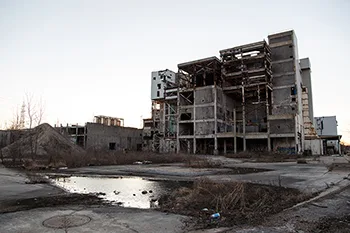
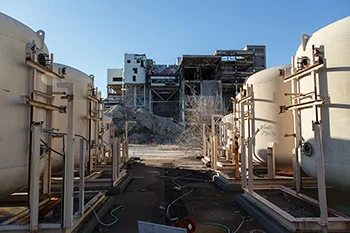 Lever Soap Plant of Saint Louis was built in 1953 and lasted nearly 50 years in operation, before closing in 2001 as a result of restructuring. "Lever Brothers was a British manufacturer founded in 1885 by William Hesketh Lever (1851–1925) and his brother, James Darcy Lever (1854–1910). The brothers had invested in and promoted a new soap making process invented by chemist William Hough Watson, it was a huge success. Lever Brothers merged with Margarine Unie in 1930 to form Unilever." - wiki
Lever Soap Plant of Saint Louis was built in 1953 and lasted nearly 50 years in operation, before closing in 2001 as a result of restructuring. "Lever Brothers was a British manufacturer founded in 1885 by William Hesketh Lever (1851–1925) and his brother, James Darcy Lever (1854–1910). The brothers had invested in and promoted a new soap making process invented by chemist William Hough Watson, it was a huge success. Lever Brothers merged with Margarine Unie in 1930 to form Unilever." - wiki
Factory #6
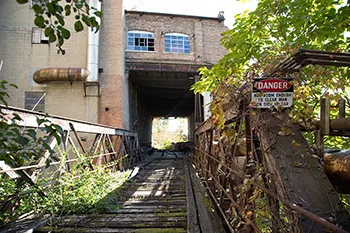
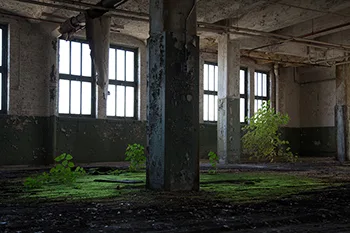 Factory #6 is an interesting little place we stumbled across on a road trip not long ago. They had a train bridge going over a water reservoir and no real indication (that i could find) as to what the hell it was they actually did here.
Factory #6 is an interesting little place we stumbled across on a road trip not long ago. They had a train bridge going over a water reservoir and no real indication (that i could find) as to what the hell it was they actually did here.
The Glass Factory
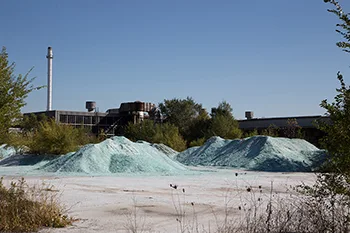
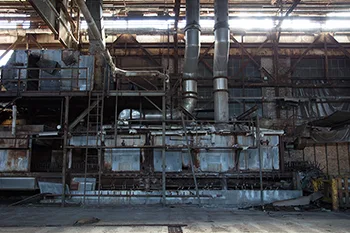 Here we have an abandoned glass factory which sits right behind the active one.
Here we have an abandoned glass factory which sits right behind the active one.
Carter Carburetor Corporation
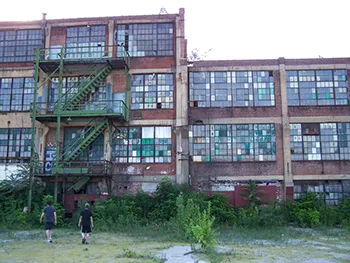
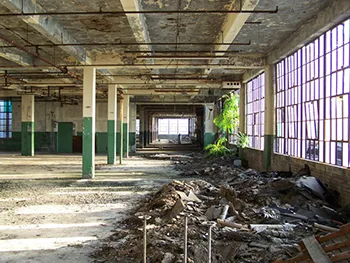 The Carter Carburetor Corporation of Saint Louis was built in the 1920's and operated here until 1984. The company was founded by William Carter, a bicycle shop owner who experimented with automotive carburetors. He soon sold the company to the American Car and Foundry company (ACF), which had been instrumental in the earliest refrigerated railcars (utilized by Anheuser Busch and Armour & Co) and whose Berwick plant built the first ever all-steel passenger locomotive car. Saint Louis' Carter Carburetor plant manufactured carburetors for gasoline as well as diesel engines. Carter Produced the first Four-Barrel carburetor in America, which was among the most popular carburetor type. It was used on many brands of cars and was especially suited for high power engines. Carter even produced their competitor's products (the Rochester Quadrajet) when the demand was high enough. Other notable carburetors produced here were those made for the Willys Jeeps. These modified carburetors were waterproof and the Y-S model was capable of keeping the engine running even at steep inclines.
The rise of fuel injection meant the downfall of the carburetor in automobiles and in 1984, the plant closed. It is currently an EPA superfund site due to PCB and other contaminations, the cleanup of which is estimated to cost $30 million.
The Carter Carburetor Corporation of Saint Louis was built in the 1920's and operated here until 1984. The company was founded by William Carter, a bicycle shop owner who experimented with automotive carburetors. He soon sold the company to the American Car and Foundry company (ACF), which had been instrumental in the earliest refrigerated railcars (utilized by Anheuser Busch and Armour & Co) and whose Berwick plant built the first ever all-steel passenger locomotive car. Saint Louis' Carter Carburetor plant manufactured carburetors for gasoline as well as diesel engines. Carter Produced the first Four-Barrel carburetor in America, which was among the most popular carburetor type. It was used on many brands of cars and was especially suited for high power engines. Carter even produced their competitor's products (the Rochester Quadrajet) when the demand was high enough. Other notable carburetors produced here were those made for the Willys Jeeps. These modified carburetors were waterproof and the Y-S model was capable of keeping the engine running even at steep inclines.
The rise of fuel injection meant the downfall of the carburetor in automobiles and in 1984, the plant closed. It is currently an EPA superfund site due to PCB and other contaminations, the cleanup of which is estimated to cost $30 million.
Pevely Dairy Farm
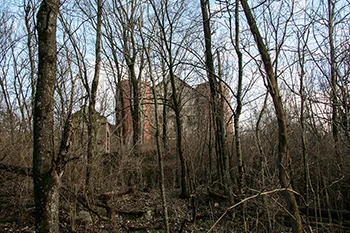
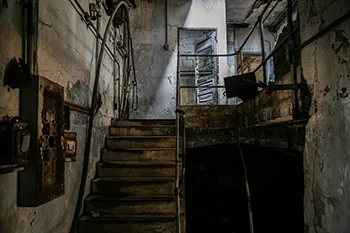 This farm was the oldest and largest of its kind, from the time of its founding in 1887, to the time it was sold to a competitor in 1989. Throughout this time, the farm remained under control of the original family. The 1989 acqusition added $60 million of annual revenue. The farm was abandoned by 1989 at the time the company was sold. The family mansion remains nearby, abandoned as well.
This farm was the oldest and largest of its kind, from the time of its founding in 1887, to the time it was sold to a competitor in 1989. Throughout this time, the farm remained under control of the original family. The 1989 acqusition added $60 million of annual revenue. The farm was abandoned by 1989 at the time the company was sold. The family mansion remains nearby, abandoned as well.
The Grand Incinerator
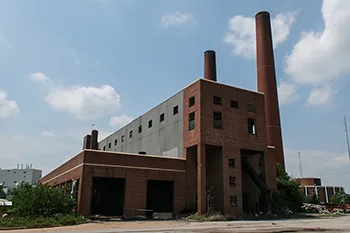
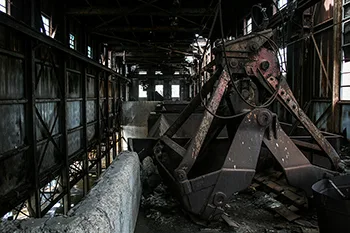 This Industrial site was built in the 1950's for incinerating the waste of Saint Louis. It remained in operation until the mid 1980's, its last inspection having occurred in 1984. Since the time of its closure it was temporarily used as a garage and storage facility for the Refuse Division. It has since been abandoned completely and fenced off.
This Industrial site was built in the 1950's for incinerating the waste of Saint Louis. It remained in operation until the mid 1980's, its last inspection having occurred in 1984. Since the time of its closure it was temporarily used as a garage and storage facility for the Refuse Division. It has since been abandoned completely and fenced off.
Incinerator #2
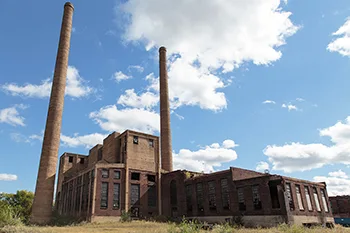
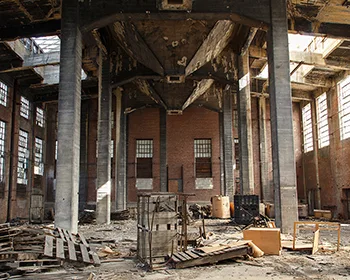 I've searched high and low and have not been able to determine with certainty was this place was originally. I suspect it was an incinerator, based on the large hoppers and dual stacks (as compared to a known incinerator). But this is a guess. Currently and, as it seems to have been the case for the past several years, it was used a rubber scrap facility. Its original purpose had been forgotten long before any clues could have wound up on the internet. Even the EPA merely lists it generically as "Former Industrial Site".
I've searched high and low and have not been able to determine with certainty was this place was originally. I suspect it was an incinerator, based on the large hoppers and dual stacks (as compared to a known incinerator). But this is a guess. Currently and, as it seems to have been the case for the past several years, it was used a rubber scrap facility. Its original purpose had been forgotten long before any clues could have wound up on the internet. Even the EPA merely lists it generically as "Former Industrial Site".
A. P. Greene Brick Refractory
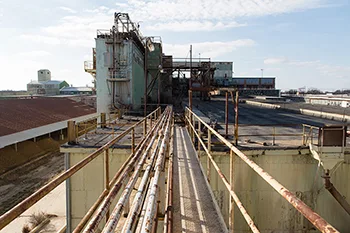
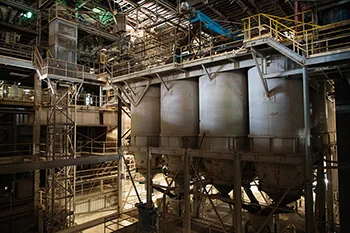 The A.P. Green Fire Brick Refractory was constructed in Mexico, Missouri as the Salamander Stove-Lining Company in 1887. Following several name changes and business reorganizations, Allen Percival Green bought the company in 1910 and renamed the business to the one bearing his name in 1915. The company would become incredibly successful in subsequent years and by World War II, A.P. Green was a major supplier to the U.S. Government's war effort. The success continued from there as the steel industry required bricks that could withstand the increasingly high temperatures of the steel making process and in so doing turned to AP Green who formulated the new KX-99 fire bricks. Notable steel giant Bethlehem Steel was AP Green's largest customer.
The A.P. Green Fire Brick Refractory was constructed in Mexico, Missouri as the Salamander Stove-Lining Company in 1887. Following several name changes and business reorganizations, Allen Percival Green bought the company in 1910 and renamed the business to the one bearing his name in 1915. The company would become incredibly successful in subsequent years and by World War II, A.P. Green was a major supplier to the U.S. Government's war effort. The success continued from there as the steel industry required bricks that could withstand the increasingly high temperatures of the steel making process and in so doing turned to AP Green who formulated the new KX-99 fire bricks. Notable steel giant Bethlehem Steel was AP Green's largest customer.
Wellsville Fire Brick
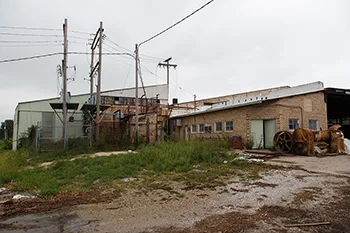
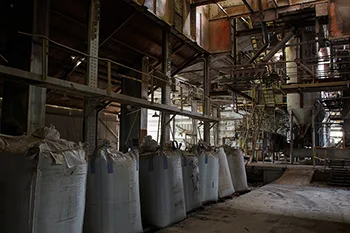 Wellsville Fire Brick began running its first kiln in March of 1919 and soon expanded significantly, running a large and successful business for nearly 100 years before dissolving in 2006. The last products from the assembly line still sit gathering dust to this day.
Wellsville Fire Brick began running its first kiln in March of 1919 and soon expanded significantly, running a large and successful business for nearly 100 years before dissolving in 2006. The last products from the assembly line still sit gathering dust to this day.
NARCO Brick Refractory
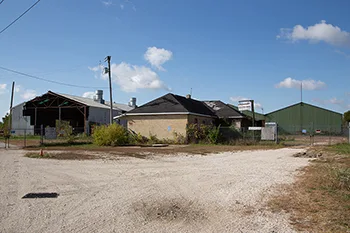
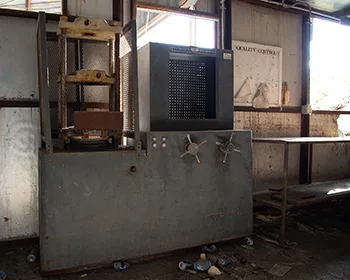 North American Refractories (NARCO) operated a brick manufacturing plant in this location when it was built in 1960 until approximately 2006. It was sold to a salvage company which is slowly dismantling the site.
North American Refractories (NARCO) operated a brick manufacturing plant in this location when it was built in 1960 until approximately 2006. It was sold to a salvage company which is slowly dismantling the site.
The Pillsbury Mill
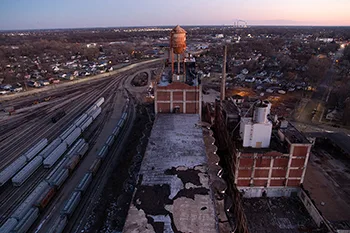
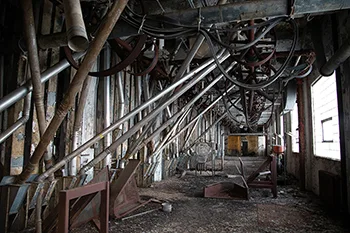 The Pillsbury Mill was built in 1929. In 1989 a large British conglomerate purchased the company and moved production elsewhere. About a year later they sold this plant to Cargill. Cargill then operated it for 10 years and when they closed in 2001, they apparently didn't bother taking anything with them when they left. Salvage companies came and went with one who imporperly disposed of asbestos and saw one of its officers jailed for two years as a result. Another group has come forward and purchased it with dreams of progress at the site but for now it's still just a huge deathtrap deteriorating next to a large neighborhood.
The Pillsbury Mill was built in 1929. In 1989 a large British conglomerate purchased the company and moved production elsewhere. About a year later they sold this plant to Cargill. Cargill then operated it for 10 years and when they closed in 2001, they apparently didn't bother taking anything with them when they left. Salvage companies came and went with one who imporperly disposed of asbestos and saw one of its officers jailed for two years as a result. Another group has come forward and purchased it with dreams of progress at the site but for now it's still just a huge deathtrap deteriorating next to a large neighborhood.
Falling Spring Mill
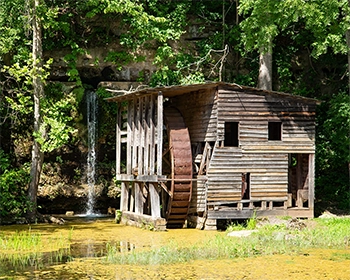
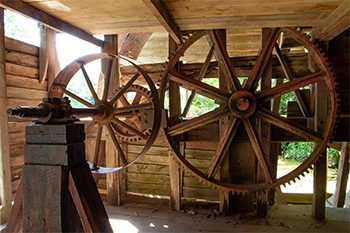 Falling Spring Mill was constructed between 1927-1929 and served multiple functions despite its small size; It was used as a typical mill which was used to grind various grains but it was also used as a sawmill and even a generator of electricity. The mill sits beneath a spring waterfall which flows out of a cave opening about 15 feet up on the bluff behind. In 1851, this area was homesteaded by Thomas and Jane Brown and their cabin remains standing here on the site.
Falling Spring Mill was constructed between 1927-1929 and served multiple functions despite its small size; It was used as a typical mill which was used to grind various grains but it was also used as a sawmill and even a generator of electricity. The mill sits beneath a spring waterfall which flows out of a cave opening about 15 feet up on the bluff behind. In 1851, this area was homesteaded by Thomas and Jane Brown and their cabin remains standing here on the site.
Alley Spring Mill
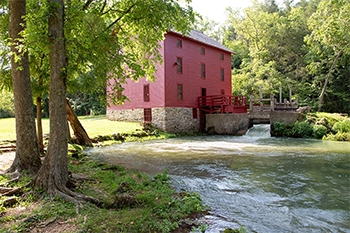
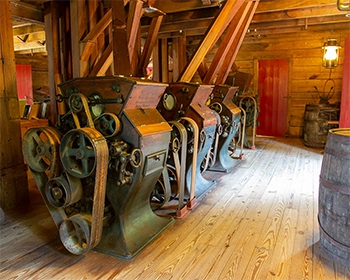 Alley Spring Mill was constructed near Eminence, Missouri in 1893-1894 by George Washington McCaskill. A Leffel turbine installed beneath the back porch powered the mill via a driveshaft in the basement which was in turn connected to various belts which powered the machinery inside. Grain to be milled was placed into bins on the first floor through which they were conveyed to the milling machines which ground the grains into flour. On the second floor, the flour was sifted through a series of silk sieves which, by filtering the material, a uniform consistency was achieved.
Alley Spring Mill was constructed near Eminence, Missouri in 1893-1894 by George Washington McCaskill. A Leffel turbine installed beneath the back porch powered the mill via a driveshaft in the basement which was in turn connected to various belts which powered the machinery inside. Grain to be milled was placed into bins on the first floor through which they were conveyed to the milling machines which ground the grains into flour. On the second floor, the flour was sifted through a series of silk sieves which, by filtering the material, a uniform consistency was achieved.
The Oil Recycler
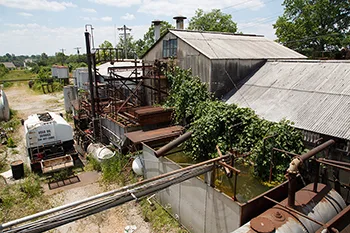
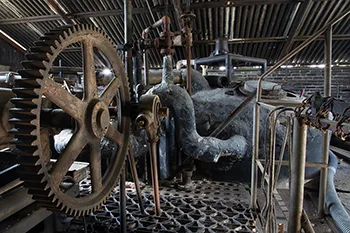 The Oil Recycler was established in the 1970s and was operational until sometime around 2014. Despite a small staff their annual revenue had reached tens of millions of dollars at one time, though I'm guessing that was during its prime, which appears to have been a couple decades ago.
The Oil Recycler was established in the 1970s and was operational until sometime around 2014. Despite a small staff their annual revenue had reached tens of millions of dollars at one time, though I'm guessing that was during its prime, which appears to have been a couple decades ago.
Calco Incorporated
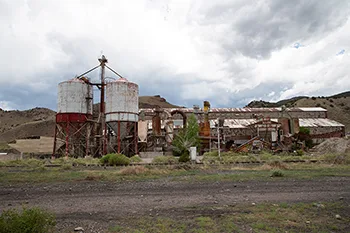
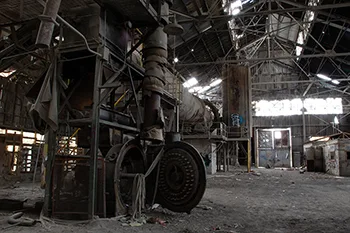 Calco Inc. operated this plant in Salida Colorado from the mid/late 70's to the mid 90s. They processed on average 200 tons of quicklime and crushed limestone daily which was hauled from the nearby Monarch Quarry. By the early 1990's they had numerous MSHA citations wherein their weak financial situation was acknowledged as reason for their rather small fines (~$50 per citation). It's not clear when they shut down but it appears to have been sometime in the mid 1990's.
Calco Inc. operated this plant in Salida Colorado from the mid/late 70's to the mid 90s. They processed on average 200 tons of quicklime and crushed limestone daily which was hauled from the nearby Monarch Quarry. By the early 1990's they had numerous MSHA citations wherein their weak financial situation was acknowledged as reason for their rather small fines (~$50 per citation). It's not clear when they shut down but it appears to have been sometime in the mid 1990's.
ASARCO Superfund
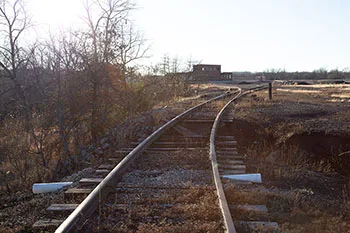
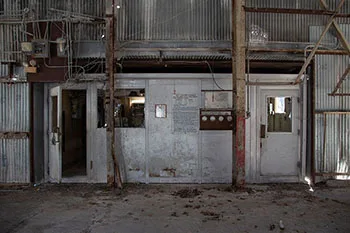 American Smelting and Refining Company (ASARCO) of Taylor Springs Illinois began under a slightly different name at this location in 1912. They were involved in zinc and lead smelting and refining as well as sulfuric acid production in addition to coal mining and storage, primary and secondary slab zinc production and both American and French Process zinc oxide production. Waste products from plant operations were conveniently dumped on-site and coal ash from the plant’s gas producing operations was casually spread on the ground. Slag piles were found to contain lead, arsenic, cadmium and other problematic metals. To what was surely the surprise of everyone involved, these methods of "storage" resulted in the contamination of both surface water and soil. This contamination not only extended onto adjacent residential properties but some waste materials were also used as fill dirt in the neighborhoods near the site. ASARCO LLC purchased the property from American Zinc and Lead in 1971 and they continued zinc smelting and refining activities. They then leased the facility to Midwest Zinc-Hillsboro, which remained in operation until 2004. EPA SUPERFUN SITE
A 1912 industrial site sounded super fun to me. It was an hour long drive to the best parking spot and a decent hike on top of that before we could even get eyes on the site and learn what, if anything, was still standing. It wasn't until we walked up out of the trees and finally laid eyes on the objective that we knew some, possibly all, of the original buildings still stood. I started to get my hopes up at this point. It looked like we had an office building in the front with some garages/shops in the middle and then the main production site in the rear-complete with a big ass power plant building that had a crazy ventilation fan sticking out of the side of it. It looked like it was going to be awesome. Very excited by this point to head in and see what's left.
American Smelting and Refining Company (ASARCO) of Taylor Springs Illinois began under a slightly different name at this location in 1912. They were involved in zinc and lead smelting and refining as well as sulfuric acid production in addition to coal mining and storage, primary and secondary slab zinc production and both American and French Process zinc oxide production. Waste products from plant operations were conveniently dumped on-site and coal ash from the plant’s gas producing operations was casually spread on the ground. Slag piles were found to contain lead, arsenic, cadmium and other problematic metals. To what was surely the surprise of everyone involved, these methods of "storage" resulted in the contamination of both surface water and soil. This contamination not only extended onto adjacent residential properties but some waste materials were also used as fill dirt in the neighborhoods near the site. ASARCO LLC purchased the property from American Zinc and Lead in 1971 and they continued zinc smelting and refining activities. They then leased the facility to Midwest Zinc-Hillsboro, which remained in operation until 2004. EPA SUPERFUN SITE
A 1912 industrial site sounded super fun to me. It was an hour long drive to the best parking spot and a decent hike on top of that before we could even get eyes on the site and learn what, if anything, was still standing. It wasn't until we walked up out of the trees and finally laid eyes on the objective that we knew some, possibly all, of the original buildings still stood. I started to get my hopes up at this point. It looked like we had an office building in the front with some garages/shops in the middle and then the main production site in the rear-complete with a big ass power plant building that had a crazy ventilation fan sticking out of the side of it. It looked like it was going to be awesome. Very excited by this point to head in and see what's left.
Pevely Dairy Plant
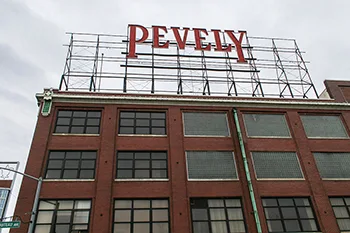
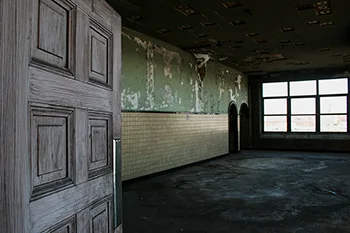 The Saint Louis Pevely Dairy Plant operated as a dairy production facility, a stable used for horse-wagon deliveries, the company's headquarters and even a soda fountain on the ground floor. The company itself was owned and operated from its founding in the 1880s through 1989, when it was bought by Prairie Farms Dairy. The oldest building on the site dated to 1915 and was located at the southwest corner of Grand Avenue and Manchester Road. It housed the offices for the company on four stories. In 1916, Pevely added a brick and concrete factory building on the site, located at 3626 Chouteau Avenue. The factory underwent expansions in 1943, 1945, 1975, and 1997; in addition, a garage was built south of the factory at 1101 Motard Avenue in 1928, and a smokestack on the site that dates to 1943 includes glazed brick lettering that spells out Pevely. The marquee sign for the Pevely Dairy Company Plant was a familiar sight, located on top of the office building. In October 2008, Prairie Farms closed the factory, which was the last Pevely facility still in use. By this time, the original Pevely Dairy Farm and Homestead were already long abandoned. In August 2011, the Saint Louis University President Lawrence Biondi decided it needed to be replaced with a terribly ugly modern building on that site, despite the fact that there is plenty of vacant land nearby. The building was on the National Register but that couldn't save it, nor would the protests from the Saint Louis Preservation Board among others.
The Saint Louis Pevely Dairy Plant operated as a dairy production facility, a stable used for horse-wagon deliveries, the company's headquarters and even a soda fountain on the ground floor. The company itself was owned and operated from its founding in the 1880s through 1989, when it was bought by Prairie Farms Dairy. The oldest building on the site dated to 1915 and was located at the southwest corner of Grand Avenue and Manchester Road. It housed the offices for the company on four stories. In 1916, Pevely added a brick and concrete factory building on the site, located at 3626 Chouteau Avenue. The factory underwent expansions in 1943, 1945, 1975, and 1997; in addition, a garage was built south of the factory at 1101 Motard Avenue in 1928, and a smokestack on the site that dates to 1943 includes glazed brick lettering that spells out Pevely. The marquee sign for the Pevely Dairy Company Plant was a familiar sight, located on top of the office building. In October 2008, Prairie Farms closed the factory, which was the last Pevely facility still in use. By this time, the original Pevely Dairy Farm and Homestead were already long abandoned. In August 2011, the Saint Louis University President Lawrence Biondi decided it needed to be replaced with a terribly ugly modern building on that site, despite the fact that there is plenty of vacant land nearby. The building was on the National Register but that couldn't save it, nor would the protests from the Saint Louis Preservation Board among others.
Powell Square
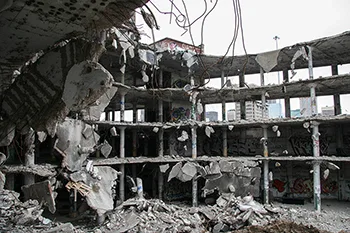
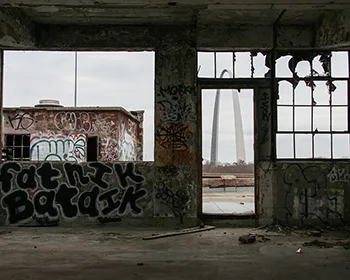 "The Powell Square Building was constructed in 1916 as the headquarters for the John T. Milliken Pharmaceutical and Absorbent Cotton Plant. When Mr. Milliken died from pneumonia three years later, he was said to be the richest man in St. Louis. The buildings architect was William Wedemeyer, who's architectural firm is the predecessor of Wedemeyer-Cernick-Corrubia, which still operates today. In 1926, the building was purchased by the Fulton Bag and Cotton Mill Company. The transaction was unusual in that as part of Fulton Bag's payment for the building on Cedar, their former building at 12 South Seventh Street was transferred to Milliken Pharmaceutical, who moved into the building and remained for several years. The building on South Seventh still stands and was renovated several years as the Fulton Bag Lofts. Photo above ca. 1930 from the Georgia Institute of Technology. In 1952 Fulton Bag added the truck dock addition to the east side of the building, also completely constructed of formed concrete. in 1956, Fulton Bag moved to a new building constructed for the company on Gustine Avenue. General Fibre Company purchased the former Milliken plant in 1957 and occupied the building for several years. Between that time and 2001, the building had numerous owners/tenants, one of which was the Dan Powell Co. Inc., which gave the building its current name Powell Square."
All research credit goes to (and above text word for word copied from) Paul @: https://vanishingstl.blogspot.com/2013/01/city-burns-cash-and-opportunity-with.html
"The Powell Square Building was constructed in 1916 as the headquarters for the John T. Milliken Pharmaceutical and Absorbent Cotton Plant. When Mr. Milliken died from pneumonia three years later, he was said to be the richest man in St. Louis. The buildings architect was William Wedemeyer, who's architectural firm is the predecessor of Wedemeyer-Cernick-Corrubia, which still operates today. In 1926, the building was purchased by the Fulton Bag and Cotton Mill Company. The transaction was unusual in that as part of Fulton Bag's payment for the building on Cedar, their former building at 12 South Seventh Street was transferred to Milliken Pharmaceutical, who moved into the building and remained for several years. The building on South Seventh still stands and was renovated several years as the Fulton Bag Lofts. Photo above ca. 1930 from the Georgia Institute of Technology. In 1952 Fulton Bag added the truck dock addition to the east side of the building, also completely constructed of formed concrete. in 1956, Fulton Bag moved to a new building constructed for the company on Gustine Avenue. General Fibre Company purchased the former Milliken plant in 1957 and occupied the building for several years. Between that time and 2001, the building had numerous owners/tenants, one of which was the Dan Powell Co. Inc., which gave the building its current name Powell Square."
All research credit goes to (and above text word for word copied from) Paul @: https://vanishingstl.blogspot.com/2013/01/city-burns-cash-and-opportunity-with.html
Norman Industrial Laundry Corporation
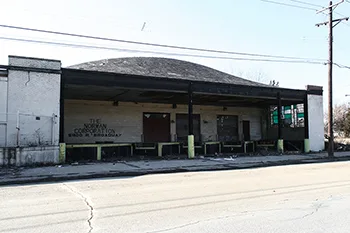
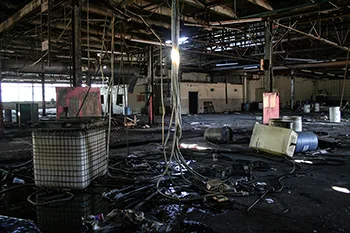 "The site was originally owned and operated by McCabe and Powers who manufactured jeep and truck chassis during World War II. The property was purchased from McCabe and Powers by American Linen in the 1960s. American Linen operated the site as a commercial laundry until it was sold in the mid-1980s to Charlie Gallagher who maintained the site as a commercial laundry. The property was again sold in the late-1980s to the Norman Corporation, which continued to operate the site as a commercial laundry until it ceased most operations in the late 1990s"
"The site was originally owned and operated by McCabe and Powers who manufactured jeep and truck chassis during World War II. The property was purchased from McCabe and Powers by American Linen in the 1960s. American Linen operated the site as a commercial laundry until it was sold in the mid-1980s to Charlie Gallagher who maintained the site as a commercial laundry. The property was again sold in the late-1980s to the Norman Corporation, which continued to operate the site as a commercial laundry until it ceased most operations in the late 1990s"
Concrete Ruins
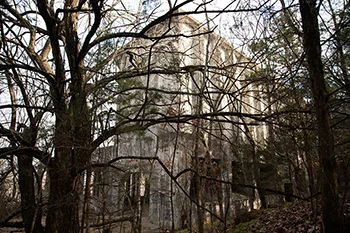
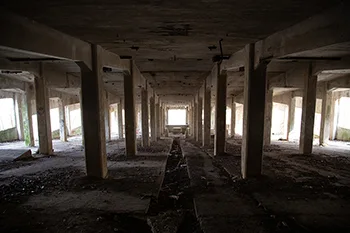 The Concrete Ruins used to be part of a large mine. Aside from sorting raw material, it's difficult to say what exactly these structures once housed or what methods were used in sorting. There were large hoppers at the top of the tallest buildings which funneled material into lower parts of the structures, through holes in the floor and down a long slope. The existence of a large water basin along with channels in the floors from the top sorting station down the hill lead me to believe water was employed in funneling ore to different end points below. The building towards the base of the hill could have thus been a pump house and the one next to it may have been the hopper where the final product of this facility was loaded into trucks and hauled off.
The Concrete Ruins used to be part of a large mine. Aside from sorting raw material, it's difficult to say what exactly these structures once housed or what methods were used in sorting. There were large hoppers at the top of the tallest buildings which funneled material into lower parts of the structures, through holes in the floor and down a long slope. The existence of a large water basin along with channels in the floors from the top sorting station down the hill lead me to believe water was employed in funneling ore to different end points below. The building towards the base of the hill could have thus been a pump house and the one next to it may have been the hopper where the final product of this facility was loaded into trucks and hauled off.
Crunden Martin Building #5
Crunden-Martin manufactured woodenware and metal goods in this location from 1891 to 1990. "As early as 1882, the St. Louis riverfront became the nation's chief distribution point of wooden and willow wares. The woodenware trade included an extensive variety of articles including buckets, casks, tubs, ladles, bread bowls and other household utensils. Willow ware included baskets and other articles. With the rising local industry came associated cordage, rope, brooms, wrapping paper, paper bags, stove polish and axle grease. During WWII, Crunden-Martin manufactured helmets, stoves, buckets and five-gallon gasoline 'jerry cans' for the U. S. military." In 1990 Crunden-Martin filled bankruptcy and the buildings were sold at auction two years later. On December 8, 2011, building #5 (constructed in 1912) caught fire. Luckily the majority of the damage was limited to the top three floors.
Cement Plant
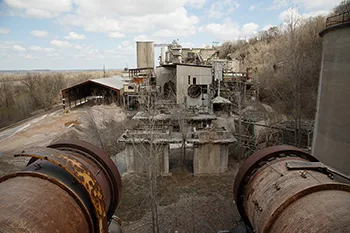
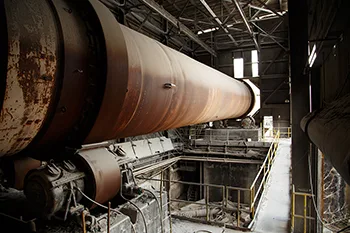 The cement plant is currently active and runs a large underground room and pillar mine at this location. These crumbling structures stand just outside their main entrance and butt right up against their active buildings.
The cement plant is currently active and runs a large underground room and pillar mine at this location. These crumbling structures stand just outside their main entrance and butt right up against their active buildings.
The Jungle Gym
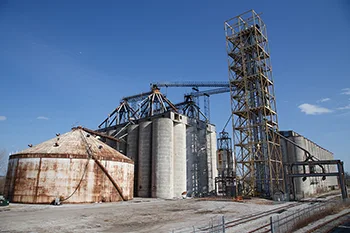
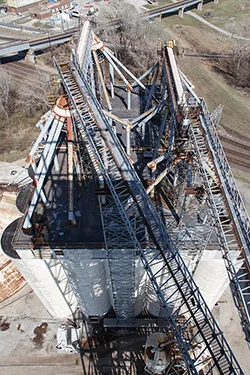 This place is known as the Jungle Gym. I'm not sure what the real name of it is, nor do I know what materials they dealt with here. I do know that it's pretty tall and it smells like shit.
This place is known as the Jungle Gym. I'm not sure what the real name of it is, nor do I know what materials they dealt with here. I do know that it's pretty tall and it smells like shit.
Vindicator Valley Trail of Gold
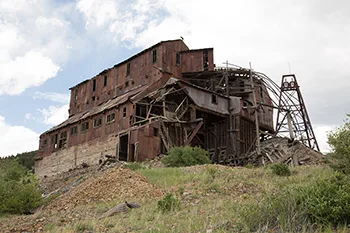
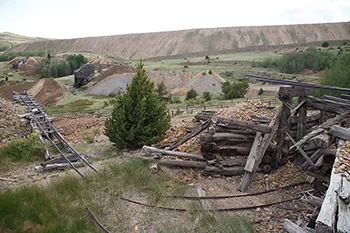 The Vindicator Valley Trail is a 2-mile hiking trail which loops around a veritable gold mine of... gold mines. Countless gold mining operations set up camp in this valley over 100 years ago. Massive mining operations once dominated the hillside and large towns grew around them. Today there is very little left of both the mines and the towns which supported them. The crumbling ghosts of once mighty industries now dot the hills in silence. Fortunately, the ruins are now preserved in place and visitors can hike the interpretive trail which provides historic information and the chance to witness these awesome relics up close. There's very little left of what used to be but considering the alternative, it's incredible that there's anything left at all-especially when you consider these old wooden structures are 100 years old.
The Vindicator Valley Trail is a 2-mile hiking trail which loops around a veritable gold mine of... gold mines. Countless gold mining operations set up camp in this valley over 100 years ago. Massive mining operations once dominated the hillside and large towns grew around them. Today there is very little left of both the mines and the towns which supported them. The crumbling ghosts of once mighty industries now dot the hills in silence. Fortunately, the ruins are now preserved in place and visitors can hike the interpretive trail which provides historic information and the chance to witness these awesome relics up close. There's very little left of what used to be but considering the alternative, it's incredible that there's anything left at all-especially when you consider these old wooden structures are 100 years old.
The Old Lead Mine and Mill
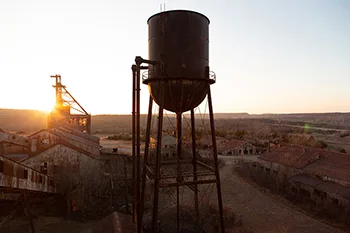
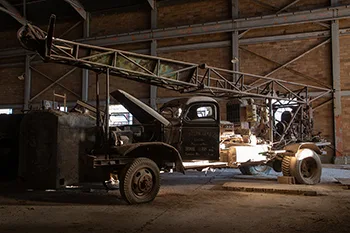 The old Missouri lead mine is a site of local significance, especially as it pertains to the history of the area. It was built in the early 1900's and was retired in the early 1970's at which point the land was donated and converted to a park. This location has been the object of my interest for a long, long time, so I did some homework. One aspect of this research was scheduling an onsite visit as a typical tourist where I saw and learned all that I could onsite, within the unreasonably strict legal boundaries they've implemented here. I spoke to the people onsite who seemed to almost brag about the fact that "nobody gets permission" to explore it. Even Ford Motor Company was denied the right to access the site for a commercial once upon a time. I was told "You can try to ask for permission but there's so much red tape you can just count on it not happening". If you decide to visit this location, you are granted access inside of ONE building-as long as you pay for the privilege: The former powerplant was converted into a museum and bears absolutely no resemblance to its original interior. Inside, it could be any other boring mid-century square brick building. The displays themselves are pretty decent, if you're a rock nerd and to a lesser extent a history dweeb (things which I am admittedly guilty of being from time to time). Many of the displays however, while interesting, don't even pertain to this site and what was mined here(!). Outside, you can peek in approximately one window and one doorway of the main plant building opposite the museum. You are allowed to walk from there, in a straight line, down to the end of the row of buildings. THAT'S IT. If you try to see more of this PUBLIC park which is maintained by our tax dollars, you are obviously a no-good filthy godddamned criminal!* (*they didn't actually say this last part, I'm just paraphrasing their stated rules here with some artistic license added).
The old Missouri lead mine is a site of local significance, especially as it pertains to the history of the area. It was built in the early 1900's and was retired in the early 1970's at which point the land was donated and converted to a park. This location has been the object of my interest for a long, long time, so I did some homework. One aspect of this research was scheduling an onsite visit as a typical tourist where I saw and learned all that I could onsite, within the unreasonably strict legal boundaries they've implemented here. I spoke to the people onsite who seemed to almost brag about the fact that "nobody gets permission" to explore it. Even Ford Motor Company was denied the right to access the site for a commercial once upon a time. I was told "You can try to ask for permission but there's so much red tape you can just count on it not happening". If you decide to visit this location, you are granted access inside of ONE building-as long as you pay for the privilege: The former powerplant was converted into a museum and bears absolutely no resemblance to its original interior. Inside, it could be any other boring mid-century square brick building. The displays themselves are pretty decent, if you're a rock nerd and to a lesser extent a history dweeb (things which I am admittedly guilty of being from time to time). Many of the displays however, while interesting, don't even pertain to this site and what was mined here(!). Outside, you can peek in approximately one window and one doorway of the main plant building opposite the museum. You are allowed to walk from there, in a straight line, down to the end of the row of buildings. THAT'S IT. If you try to see more of this PUBLIC park which is maintained by our tax dollars, you are obviously a no-good filthy godddamned criminal!* (*they didn't actually say this last part, I'm just paraphrasing their stated rules here with some artistic license added).
Colorado Gold Mines
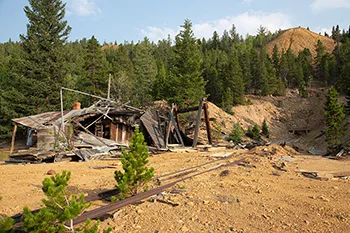
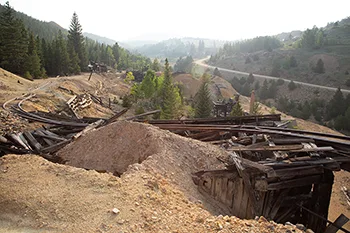 The area in which these mines reside is one of the most significant locations in Colorado in terms of gold deposits, having helped spur the gold rush of 1859. Within two months of the first reports of gold discovered here, 10,000 people had moved into town and it was soon called the "richest square mile on earth". All the veins in the region were initially easy to mine as they were already oxidized and decomposed at the surface and as a result the gold output here surpassed that of all other mining districts in Colorado combined, up until the 1880s, and still today ranks second highest overall in terms of gold production. There were also substantial amounts of silver, lead, copper and zinc mined here. In the 100 years spanning 1859 to 1959 this county produced roughly 4,255,000 ounces of gold which would be worth $7.2 Billion today. And much of that gold came from the the very mines I explored and photographed here.
The area in which these mines reside is one of the most significant locations in Colorado in terms of gold deposits, having helped spur the gold rush of 1859. Within two months of the first reports of gold discovered here, 10,000 people had moved into town and it was soon called the "richest square mile on earth". All the veins in the region were initially easy to mine as they were already oxidized and decomposed at the surface and as a result the gold output here surpassed that of all other mining districts in Colorado combined, up until the 1880s, and still today ranks second highest overall in terms of gold production. There were also substantial amounts of silver, lead, copper and zinc mined here. In the 100 years spanning 1859 to 1959 this county produced roughly 4,255,000 ounces of gold which would be worth $7.2 Billion today. And much of that gold came from the the very mines I explored and photographed here.
The Gold Mine
In the late 1800's, prospectors discovered a large gold deposit beneath the hills on which this mine is now located. This discovery went on to become one of the most prosperous gold mines in the area for many years. Originally there were several independently claimed mines here but they were consolidated in the 1890's. In today's dollars, the gold mined here amounted to approximately $100 Million, or about 70,000 troy ounces. Armed guards were stationed inside the mine where miners were frisked before returning to the surface. The main shaft extends over 1,000 feet straight down, with nine levels branching off from it in all directions, amounting to more than 30 miles of tunnels. This gold mine operated from the late 1800's until some time around 1970. The current owner is battling legal issues which prevent it from being used in any capacity now.
Leadville Colorado
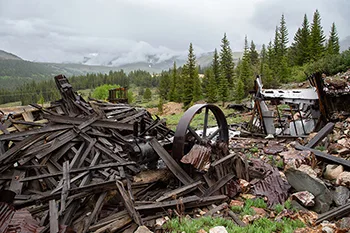
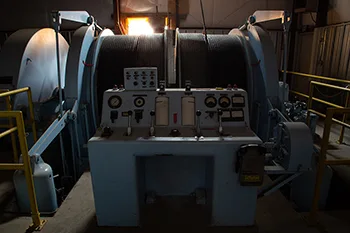 Leadville is a mountain town in central Colorado which was inhabited as early as the 16th century by the Ute Nation people. To the north of the Gunnison River the Ute Nation was mostly comprised of the Parianuche or "elk people". During the warm season, the Parianuche lived along the headwaters of the renowned Arkansas River in the area that later came to be known as Leadville. After spending the warm season along the headwaters, they moved to lower elevations in the winter. This was more or less the routine for some 300+ years before their home was invaded by people desperate to strike it rich by blasting tunnels and digging holes through the earth.
Leadville is a mountain town in central Colorado which was inhabited as early as the 16th century by the Ute Nation people. To the north of the Gunnison River the Ute Nation was mostly comprised of the Parianuche or "elk people". During the warm season, the Parianuche lived along the headwaters of the renowned Arkansas River in the area that later came to be known as Leadville. After spending the warm season along the headwaters, they moved to lower elevations in the winter. This was more or less the routine for some 300+ years before their home was invaded by people desperate to strike it rich by blasting tunnels and digging holes through the earth.
Bonanza and Rawley Mines
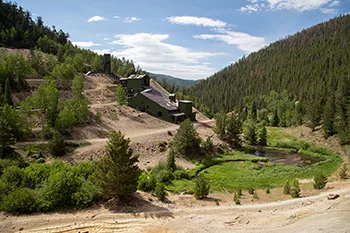
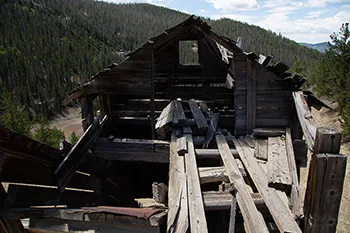 In 2017 I made my first trip to Colorado to explore The Ghost Town of Gillman Colorado along with the mine structures below. Underestimating the terrain, I legitimately risked our lives (a few different times) by not being prepared from the outset. This led to a series of unforunate events. I learned a valuable lesson that day, which I promptly forgot and then re-learned again when I was nearly search-and-rescued on our trip to The Skaguay Hydroelectric Power Plant. Woops. The lesson is simple: Nothing is easy in Colorado. About a year had passed since I explored around Leadville, so naturally I forgot all about those prior lessons despite the added difficulty doing it alone, fresh out of surgery with a broken collarbone... I'm very stupid and I can't resist a good adventure. Okay? I have Adventuritis. It's a thing.
In 2017 I made my first trip to Colorado to explore The Ghost Town of Gillman Colorado along with the mine structures below. Underestimating the terrain, I legitimately risked our lives (a few different times) by not being prepared from the outset. This led to a series of unforunate events. I learned a valuable lesson that day, which I promptly forgot and then re-learned again when I was nearly search-and-rescued on our trip to The Skaguay Hydroelectric Power Plant. Woops. The lesson is simple: Nothing is easy in Colorado. About a year had passed since I explored around Leadville, so naturally I forgot all about those prior lessons despite the added difficulty doing it alone, fresh out of surgery with a broken collarbone... I'm very stupid and I can't resist a good adventure. Okay? I have Adventuritis. It's a thing.
The Iron Mine
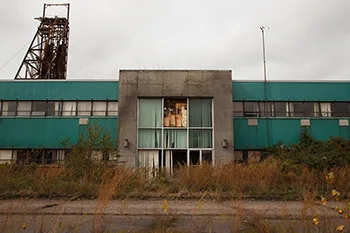
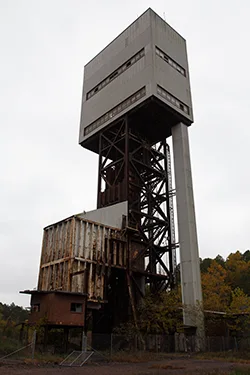 The Iron Mine was constructed in 1964. "During operation, it extracted as much as 1 million ton of rock each year. The iron ore extracted here was crushed to a size less than 1 1/2 ft. in the underground crusher. It was then hoisted to the surface and fed into a secondary crusher that took it to a size less than 6 inches. It then went into a tertiary (3rd) crusher that took it to a size less than 1 inch. After that, it went into the wet milling circuit. The mills ground the ore down to where 90% would pass through a 325 mesh screen (for the primary product). It then went through a flotation circuit to separate the impurities out. There were a few different processes after that to produce different products. Most was sold to Coal companies for use in purifying coal. Some was sold to magnet companies. Some was converted to hematite and sold for other uses".
The Iron Mine was constructed in 1964. "During operation, it extracted as much as 1 million ton of rock each year. The iron ore extracted here was crushed to a size less than 1 1/2 ft. in the underground crusher. It was then hoisted to the surface and fed into a secondary crusher that took it to a size less than 6 inches. It then went into a tertiary (3rd) crusher that took it to a size less than 1 inch. After that, it went into the wet milling circuit. The mills ground the ore down to where 90% would pass through a 325 mesh screen (for the primary product). It then went through a flotation circuit to separate the impurities out. There were a few different processes after that to produce different products. Most was sold to Coal companies for use in purifying coal. Some was sold to magnet companies. Some was converted to hematite and sold for other uses".
Vulture Tower Mine
This is a large room and pillar mine extending much further and deeper than any I have explored before and as such we only scratched the surface of what there is to see here before we ran out of time. Portions of this site are completely abandoned due to collapse, while others are still in use.
Ozora Marble Quary
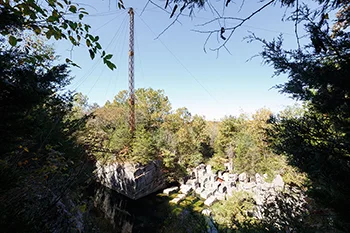
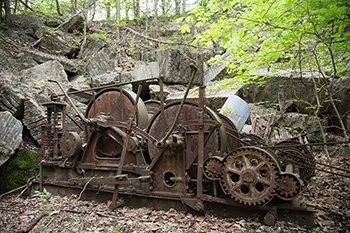 The Ozora Marble Quarry began in 1920 and was reported to have been worked continuously until 1943, when operations were permanently shut down.
Stone from the Ozora Marble Quarry (Ste. Genevieve Golden Vein and Ste. Genevieve Rose Marble) was used in the enclosures which house and protect the original copies of the Declaration of Independence, the Bill of Rights and the Constitution of the United States.
The Ozora Marble Quarry began in 1920 and was reported to have been worked continuously until 1943, when operations were permanently shut down.
Stone from the Ozora Marble Quarry (Ste. Genevieve Golden Vein and Ste. Genevieve Rose Marble) was used in the enclosures which house and protect the original copies of the Declaration of Independence, the Bill of Rights and the Constitution of the United States.
"The quarry was equipped with a stiff-leg derrick with 35-foot mast and 75-foot boom and was powered by electric motors. Pneumatic drills and quarry bars were also used. Air compressors were driven by electric motors and electricity was supplied by diesel-powered generators".
Train Tunnel Mine
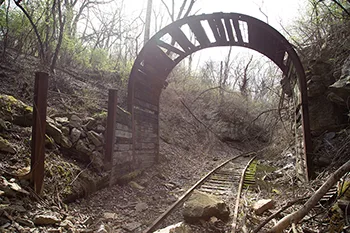
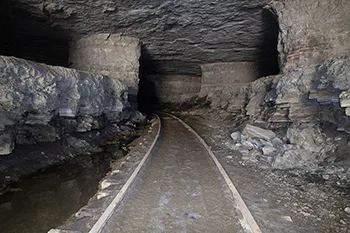 This is a pretty rad little spot called Train Tunnel Mine. The accessible portion is pretty average in overall size/layout as far as room and pillar mines go, but the unique feature here is obviously the rail line coming out of it and the train tunnel that goes deeper into the mine. Unfortunately, however, the tunnel ends abrubtly after only a hundred yards or so where a large sturdy gate prevents further exploration. Beyond the gate, within the dark and desolate expanse of these forgotten depths, electricity is loudly buzzing away, rather mysteriously, with no clear indication as to what exactly the space is being used for. Furthermore, there are no clues to tell us from where those responsible for maintaining this underground lair gain access to the site. One can only assume it's either being used for some run-of-the-mill underground storage or some clandestine government experiments involving aliens and/or lizard people.
This is a pretty rad little spot called Train Tunnel Mine. The accessible portion is pretty average in overall size/layout as far as room and pillar mines go, but the unique feature here is obviously the rail line coming out of it and the train tunnel that goes deeper into the mine. Unfortunately, however, the tunnel ends abrubtly after only a hundred yards or so where a large sturdy gate prevents further exploration. Beyond the gate, within the dark and desolate expanse of these forgotten depths, electricity is loudly buzzing away, rather mysteriously, with no clear indication as to what exactly the space is being used for. Furthermore, there are no clues to tell us from where those responsible for maintaining this underground lair gain access to the site. One can only assume it's either being used for some run-of-the-mill underground storage or some clandestine government experiments involving aliens and/or lizard people.
The Old Limestone Mine aka Sodalis Nature Preserve
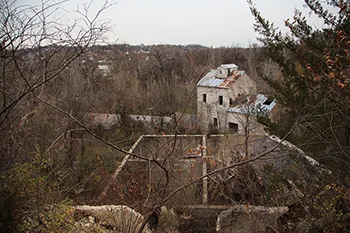
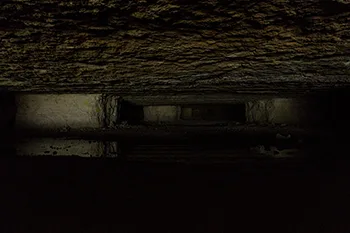 This mine was begun in the 1870's by a pair of brothers, Lyman and William. Lyman was born in the 1830s, went to school and took a job in New York by the age of 14. He worked various jobs until when, at the age of 27, he struck out for mining opportunities in what would later become Montana territory. During this trek, his team was forced to repell attacks by Native Americans. He arrived in July of 1863 and formed a mining partnership. But this region was sparsely populated and even less regulated by law and as such any disputes were settled amongst the miners themselves. Soon a vigilante group was formed and eventually executed 26 men while banishing many others. Lyman was a member of this group and personally hung 5 of the offenders. He would eventually leave, leading an expedition into unsettled territory before finally making his way to Missouri, where he would join his brother in mining. William started out working in a similar field as his brother but soon organized and became captain of a company of volunteers for the Union Army. He commanded his company through at least 4 battles of the Civil War and served until the end of the conflict. He returned home and soon started the Old Limestone Mine. This mine was later owned by a few different organizations until around 1950 when it was shuttered. UPDATE: This location is now known as the Sodalis Nature Preserve in Hannibal, Missouri. All of the buildings have been demolished and the limestone mine is gated off in order to protect the bats living here.
This mine was begun in the 1870's by a pair of brothers, Lyman and William. Lyman was born in the 1830s, went to school and took a job in New York by the age of 14. He worked various jobs until when, at the age of 27, he struck out for mining opportunities in what would later become Montana territory. During this trek, his team was forced to repell attacks by Native Americans. He arrived in July of 1863 and formed a mining partnership. But this region was sparsely populated and even less regulated by law and as such any disputes were settled amongst the miners themselves. Soon a vigilante group was formed and eventually executed 26 men while banishing many others. Lyman was a member of this group and personally hung 5 of the offenders. He would eventually leave, leading an expedition into unsettled territory before finally making his way to Missouri, where he would join his brother in mining. William started out working in a similar field as his brother but soon organized and became captain of a company of volunteers for the Union Army. He commanded his company through at least 4 battles of the Civil War and served until the end of the conflict. He returned home and soon started the Old Limestone Mine. This mine was later owned by a few different organizations until around 1950 when it was shuttered. UPDATE: This location is now known as the Sodalis Nature Preserve in Hannibal, Missouri. All of the buildings have been demolished and the limestone mine is gated off in order to protect the bats living here.
Bonne Terre Mine
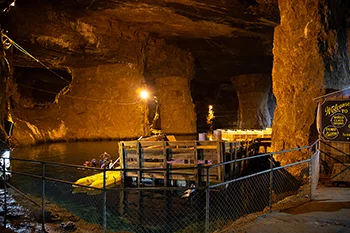
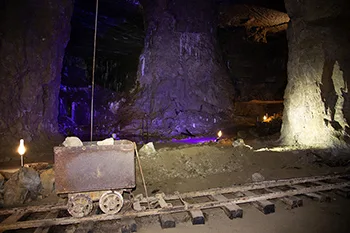 Bonne Terre Mine began in 1864 by the St Joe Lead Company and was operational until 1962-just 2 years shy of its 100th anniversary. The mine was subsequently purchased by Doe Run and then leased to West End Diving in 1976 who now operates scuba diving and tours of the underground sections which are now mostly flooded with crystal clear water. Much of the town of Bonne Terre now sits directly above this flooded mine.
I finaly got to scratch this off my to-do list recently and booked a tour of the place. I highly recommend it to anyone who's in the area. Now I just need to get into scuba diving and see what it's like beneath the water.
Bonne Terre Mine began in 1864 by the St Joe Lead Company and was operational until 1962-just 2 years shy of its 100th anniversary. The mine was subsequently purchased by Doe Run and then leased to West End Diving in 1976 who now operates scuba diving and tours of the underground sections which are now mostly flooded with crystal clear water. Much of the town of Bonne Terre now sits directly above this flooded mine.
I finaly got to scratch this off my to-do list recently and booked a tour of the place. I highly recommend it to anyone who's in the area. Now I just need to get into scuba diving and see what it's like beneath the water.
River Des Peres
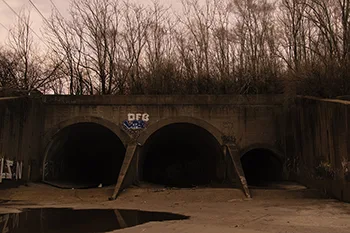
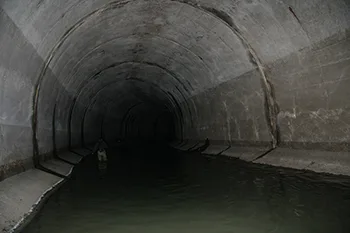 There aren't many people adventurous/stupid enough to willingly go into the sewers just to see what's going on down there. Luckily, we have the exact qualifications needed for the job.
There aren't many people adventurous/stupid enough to willingly go into the sewers just to see what's going on down there. Luckily, we have the exact qualifications needed for the job.
WWII Soviet T34/85 Medium Tank
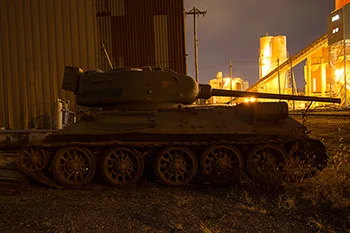
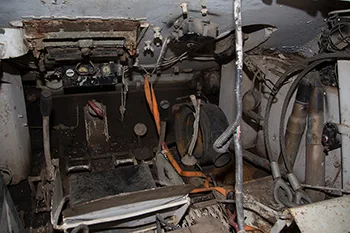 This Soviet T34/85 tank was built sometime between 1943-45. This example, which is an early variant of the T34 first produced in 1940, features a larger turret and improved interior layout of its predecessor. This tank employs an 85mm main gun and dual DT 1929 7.62x54R machine guns. The diesel powered V12 motor could propel this tank up to 26 MPH at a range of roughly 200 miles before refueling.
This Soviet T34/85 tank was built sometime between 1943-45. This example, which is an early variant of the T34 first produced in 1940, features a larger turret and improved interior layout of its predecessor. This tank employs an 85mm main gun and dual DT 1929 7.62x54R machine guns. The diesel powered V12 motor could propel this tank up to 26 MPH at a range of roughly 200 miles before refueling.
WWII Minesweeper USS Inaugural
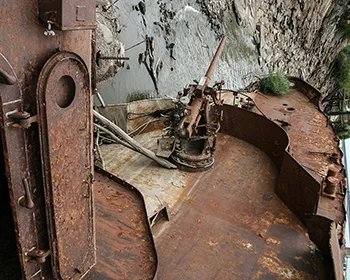
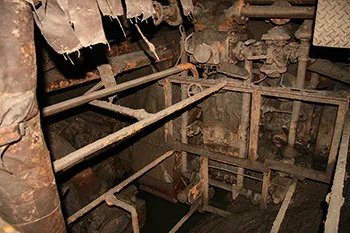 The USS Inaugural (AM-242) was an Admirable-class fleet minesweeper. The Admirable class was the largest and one of the most successful classes of U.S. minesweepers ordered during World War II. Inaugural was launched on 1 October 1944, and was commissioned on 30 December, with Lieutenant John H. Pace USNR in command.
The USS Inaugural (AM-242) was an Admirable-class fleet minesweeper. The Admirable class was the largest and one of the most successful classes of U.S. minesweepers ordered during World War II. Inaugural was launched on 1 October 1944, and was commissioned on 30 December, with Lieutenant John H. Pace USNR in command.
The ship was decommissioned in 1946 and set up as a museum ship in St. Louis, Missouri in 1968.
Inaugural had performed its duties with distinction. By the end of its career, the vessel had cleared eighty-two mines and was awarded two battle stars for service during World War II.
Inaugural was ripped from its mooring and grounded a mile downstream in the flood of 1993.
WWII German Submarine U-505
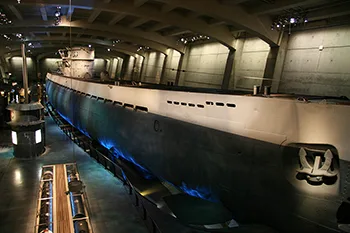
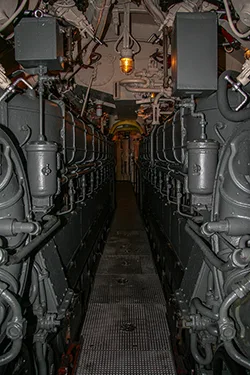 The U-505 is a German Type IXC U-boat built for service in the Kriegsmarine during World War II. She was captured on 4 June 1944 by United States Navy Task Group 22.3 (TG 22.3). Her codebooks, Enigma machine and other secret materials found on board assisted Allied code breaking operations. All but one of U-505's crew were rescued by the Navy task group. The submarine was towed to Bermuda in secret, her crew was interned at a US prisoner of war camp where they were denied access to International Red Cross visits. The Navy classified the capture as top secret and prevented its discovery by the Germans. In 1954, U-505 was donated to the Museum of Science and Industry in Chicago, Illinois and is now a museum ship. She is one of six U-boats that were captured by Allied forces during World War II, and one of four German World War II U-boats that survive as museum ships. She is the only Type IXC still in existence.
The U-505 is a German Type IXC U-boat built for service in the Kriegsmarine during World War II. She was captured on 4 June 1944 by United States Navy Task Group 22.3 (TG 22.3). Her codebooks, Enigma machine and other secret materials found on board assisted Allied code breaking operations. All but one of U-505's crew were rescued by the Navy task group. The submarine was towed to Bermuda in secret, her crew was interned at a US prisoner of war camp where they were denied access to International Red Cross visits. The Navy classified the capture as top secret and prevented its discovery by the Germans. In 1954, U-505 was donated to the Museum of Science and Industry in Chicago, Illinois and is now a museum ship. She is one of six U-boats that were captured by Allied forces during World War II, and one of four German World War II U-boats that survive as museum ships. She is the only Type IXC still in existence.
Aircraft Boneyard

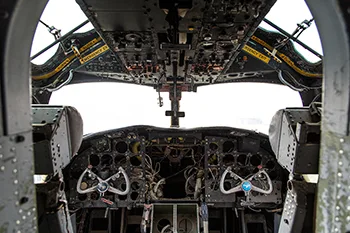 We stumbled across this lot on a recent drive and immediately decided to check it out. I'm not sure why all of these aircraft are sitting here but it seems to be related to a salvage operation.
We stumbled across this lot on a recent drive and immediately decided to check it out. I'm not sure why all of these aircraft are sitting here but it seems to be related to a salvage operation.
The Rocket Factory
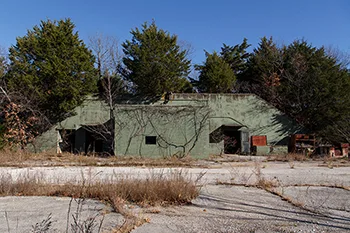
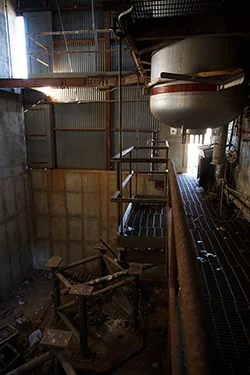 The Rocket Factory was constructed in the 1950s and during the short decade in which it was operational, it contributed significantly to the course of world history. It was decommissioned shortly afterward, in the late 1960s. Of the remaining buildings, the steel frame structures were used for testing the fuel delivery systems and gathering data. The resultant data was sent back to a reinforced bunker through a short tunnel which connected the buildings. Inside the bunkers, the data was collected and analyzed. In the case of the main control bunker, there are two longer tunnels about 100 yards in length, which connect to two separate large test pads for the rockets.
The Rocket Factory was constructed in the 1950s and during the short decade in which it was operational, it contributed significantly to the course of world history. It was decommissioned shortly afterward, in the late 1960s. Of the remaining buildings, the steel frame structures were used for testing the fuel delivery systems and gathering data. The resultant data was sent back to a reinforced bunker through a short tunnel which connected the buildings. Inside the bunkers, the data was collected and analyzed. In the case of the main control bunker, there are two longer tunnels about 100 yards in length, which connect to two separate large test pads for the rockets.
Nike Missile Base SF-88L Launch Battery
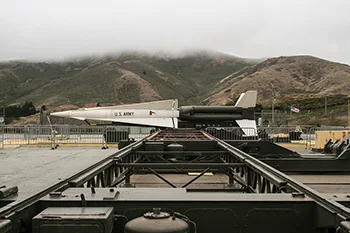
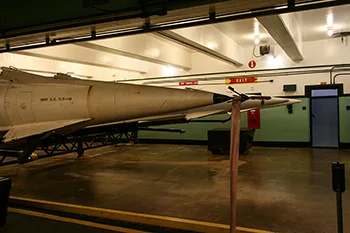 SF-88L was the launch battery of the 2nd Battalion, 56th Artillery. It was here that the Missile body and guidance system were assembled and tested. The warheads were attached in the warhead building prior to being wheeled over to the launch area and lowered into the underground storage bunker magazine known as the pit. SF-88L has two magazines, each with the capacity to store 6 missiles. The magazines are 49' long and 60' wide. At the end of each magazine, located behind blast doors, was the control room. From the control room, the crew could launch the missiles as well as raise or lower them to and from the magazine. This is technically just the launch battery. The radar Integrated Fire Control, or IFC (named SF-88C) was located just down the road. SF-88C is abandoned and I planned to visit it on this trip. However, to my surprise, the roads were gated and I only had with me street maps to the location. To make it on foot would have taken roughly several hours round trip. Since I only had about 24 hours in San Francisco, I had to make the painful decision to not visit it in order to make time for other locations that I had planned.
SF-88L was the launch battery of the 2nd Battalion, 56th Artillery. It was here that the Missile body and guidance system were assembled and tested. The warheads were attached in the warhead building prior to being wheeled over to the launch area and lowered into the underground storage bunker magazine known as the pit. SF-88L has two magazines, each with the capacity to store 6 missiles. The magazines are 49' long and 60' wide. At the end of each magazine, located behind blast doors, was the control room. From the control room, the crew could launch the missiles as well as raise or lower them to and from the magazine. This is technically just the launch battery. The radar Integrated Fire Control, or IFC (named SF-88C) was located just down the road. SF-88C is abandoned and I planned to visit it on this trip. However, to my surprise, the roads were gated and I only had with me street maps to the location. To make it on foot would have taken roughly several hours round trip. Since I only had about 24 hours in San Francisco, I had to make the painful decision to not visit it in order to make time for other locations that I had planned.
Nike Missile Base SF-87C IFC Control Site
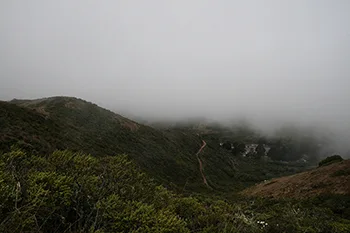
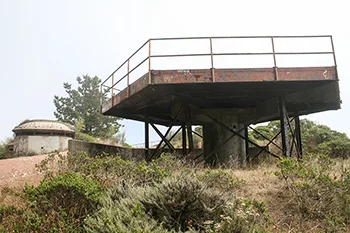 This one would have been a piece of cake, had the road not been under construction. They wouldn't let me through, so I had to hike through the mountains to get there. This trek earned me a poison ivy (technically poodle dog bush) rash from head to toe, the worst I've ever had...
This one would have been a piece of cake, had the road not been under construction. They wouldn't let me through, so I had to hike through the mountains to get there. This trek earned me a poison ivy (technically poodle dog bush) rash from head to toe, the worst I've ever had...
Nike Missile Base NY-56
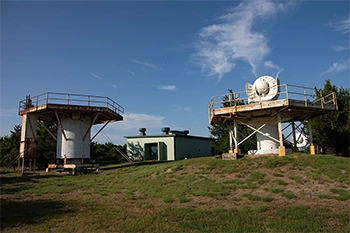
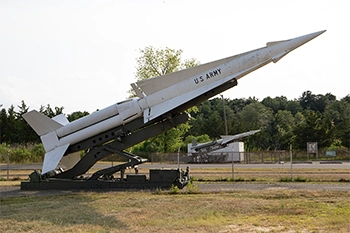 Nike Missile Base NY-56 was constructed between 1953 and 1956 and was among the first cold war defense installations activated in the United States. Nike sites were state-of-the-art facilities designed to be the last line of defense for priority sites in the U.S. which included both densely populated cities as well as military installations. Due to their critical importance in these areas, Nike missile installations were classified as Top-Secret. NY-56 was one of nineteen missile sites in the New York Defense Area which included Fort Hancock in the Northeast corner of New Jersey.
Nike Missile Base NY-56 was constructed between 1953 and 1956 and was among the first cold war defense installations activated in the United States. Nike sites were state-of-the-art facilities designed to be the last line of defense for priority sites in the U.S. which included both densely populated cities as well as military installations. Due to their critical importance in these areas, Nike missile installations were classified as Top-Secret. NY-56 was one of nineteen missile sites in the New York Defense Area which included Fort Hancock in the Northeast corner of New Jersey.
Nike Missile Base
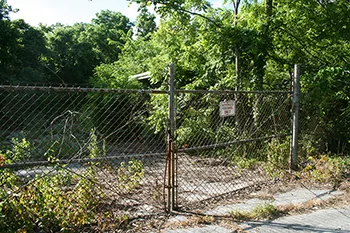
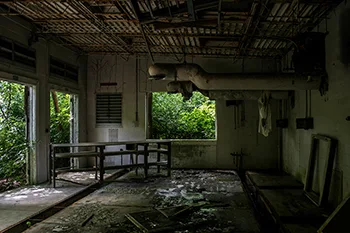 Nike Missile installations were the United States' first ground based anti-aircraft defense system, which became operational as early as 1953. They were placed in secluded locations throughout the country and were our last line of homeland defense against enemy bombers at that time. Eventually technology improved and these systems became obsolete. There isn't much left of this old Nike Missile Base now. As per the typical construction of such Cold War era missile sites, the buildings are scattered and this particular installation is spread among 3 separate areas. I have arranged them here in the order in which I explored them. Area 1 consists of the Integrated Fire Control (IFC) Area. This site contained the Nike system's ground-based radar target acquisition and computer systems. There are 3 buildings left of the IFC now. Near the entrance sits a guard shack. Further up into the woods are two more heavily overgrown structures whose original purpose has been long since forgotten.
Nike Missile installations were the United States' first ground based anti-aircraft defense system, which became operational as early as 1953. They were placed in secluded locations throughout the country and were our last line of homeland defense against enemy bombers at that time. Eventually technology improved and these systems became obsolete. There isn't much left of this old Nike Missile Base now. As per the typical construction of such Cold War era missile sites, the buildings are scattered and this particular installation is spread among 3 separate areas. I have arranged them here in the order in which I explored them. Area 1 consists of the Integrated Fire Control (IFC) Area. This site contained the Nike system's ground-based radar target acquisition and computer systems. There are 3 buildings left of the IFC now. Near the entrance sits a guard shack. Further up into the woods are two more heavily overgrown structures whose original purpose has been long since forgotten.
Battery Spencer
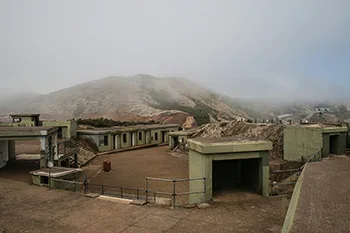
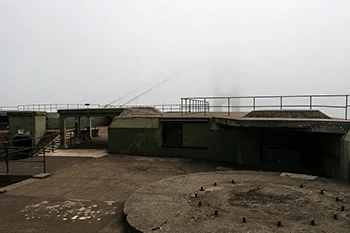 "For half a century, Battery Spencer was one of the most strategically important sites guarding the Golden Gate. Construction started in 1893 and was completed in 1897. Under the provisions of War Department General Order 16, dated 14 February 1902, it was named for Major General Joseph Spencer of the Continental Army, a hero of the Revolutionary War, who died in 1789. It was initially armed with three M1888 12-inch breech loading rifles (Made at Waterlieviet Arsenal and serial numbered 10, 16, and 17) mounted on M1892 barbette mounts (made at Watertown Arsenal and serial numbered 1, 4, and 5.) In 1917 one gun was removed to rearm Battery Chester at Fort Winfield Scott. The remaining two guns were removed and scrapped in 1943".
"For half a century, Battery Spencer was one of the most strategically important sites guarding the Golden Gate. Construction started in 1893 and was completed in 1897. Under the provisions of War Department General Order 16, dated 14 February 1902, it was named for Major General Joseph Spencer of the Continental Army, a hero of the Revolutionary War, who died in 1789. It was initially armed with three M1888 12-inch breech loading rifles (Made at Waterlieviet Arsenal and serial numbered 10, 16, and 17) mounted on M1892 barbette mounts (made at Watertown Arsenal and serial numbered 1, 4, and 5.) In 1917 one gun was removed to rearm Battery Chester at Fort Winfield Scott. The remaining two guns were removed and scrapped in 1943".
Battery Smith-Guthrie
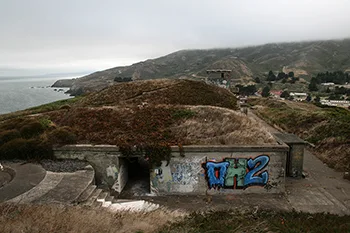
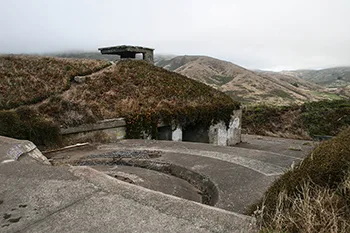 "The emplacement was named on December 27, 1904 in honor of Captain Edwin Guthrie, 15th Infantry Regiment, who died in action at La Hoya during the Mexican War in 1847. In 1922, Battery Guthrie was divided for better management of the weapons, and the two guns on the left flank were named on March 22 for Hamilton A. Smith, a West Point graduate killed in action at Soissons, France, during World War I in 1918. During World War II the guns from these two batteries were used to defend the minefields outside the Golden Gate from minesweepers. The battery was inactivated in 1945 and its guns scrapped soon thereafter".
"The emplacement was named on December 27, 1904 in honor of Captain Edwin Guthrie, 15th Infantry Regiment, who died in action at La Hoya during the Mexican War in 1847. In 1922, Battery Guthrie was divided for better management of the weapons, and the two guns on the left flank were named on March 22 for Hamilton A. Smith, a West Point graduate killed in action at Soissons, France, during World War I in 1918. During World War II the guns from these two batteries were used to defend the minefields outside the Golden Gate from minesweepers. The battery was inactivated in 1945 and its guns scrapped soon thereafter".
Army Ammunition Plant
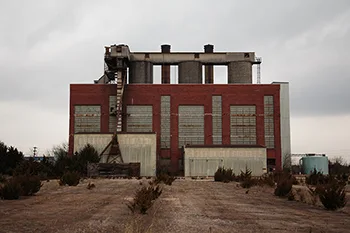
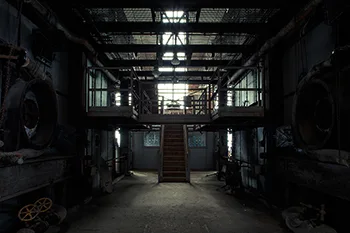 The Army Ammunition Plant was constructed in the 1940s for the purpose of contributing to the United States' war effort and it continued long after WWII ended. In fact it contributed to every major war since then, right up until the 1990s when it was finally shut down. We hiked through the woods for miles before we saw the first structure in the distance. We left the car around noon but by the time we got to the roof of the Power Plant the sun was already beginning its descent on a low arc through the western December sky. By this time the increasing clouds meant rain was threatening to soak our expedition.
The Army Ammunition Plant was constructed in the 1940s for the purpose of contributing to the United States' war effort and it continued long after WWII ended. In fact it contributed to every major war since then, right up until the 1990s when it was finally shut down. We hiked through the woods for miles before we saw the first structure in the distance. We left the car around noon but by the time we got to the roof of the Power Plant the sun was already beginning its descent on a low arc through the western December sky. By this time the increasing clouds meant rain was threatening to soak our expedition.
Castillo de San Marcos
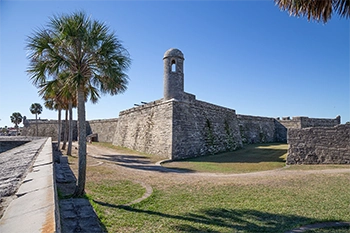
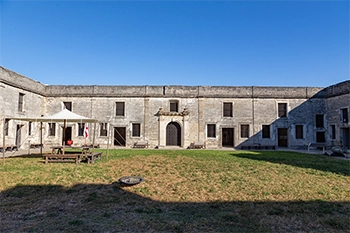 Castillo de San Marcos is a Spanish military fortification which was constructed in Saint Augustine, Florida, in 1672 and is now considered the oldest masonry structure in the United States. Designed by Ignacio Daza, construction began on October 2, 1672 and was commenced by Governor Don Manuel Cendoya in the Spanish colony of San Agustin. In 1668, San Agustin was sacked by pirates who, under the command of Robert Searle, were able to easily penetrate the town's weak defenses and raid it virtually uncontested. In response, Spanish Queen Regent Mariana quickly allocated the necessary funds and ordered a 300-man garrison to be constructed. Cendoya arrived from Spain in July of 1671 and his engineer Daza arrived the following year. Construction began in earnest in 1672, particularly after news reached of the 1670 English settlement of Charles Towne which was only a 2-days' voyage north.
Castillo de San Marcos is a Spanish military fortification which was constructed in Saint Augustine, Florida, in 1672 and is now considered the oldest masonry structure in the United States. Designed by Ignacio Daza, construction began on October 2, 1672 and was commenced by Governor Don Manuel Cendoya in the Spanish colony of San Agustin. In 1668, San Agustin was sacked by pirates who, under the command of Robert Searle, were able to easily penetrate the town's weak defenses and raid it virtually uncontested. In response, Spanish Queen Regent Mariana quickly allocated the necessary funds and ordered a 300-man garrison to be constructed. Cendoya arrived from Spain in July of 1671 and his engineer Daza arrived the following year. Construction began in earnest in 1672, particularly after news reached of the 1670 English settlement of Charles Towne which was only a 2-days' voyage north.
Fort Wadsworth
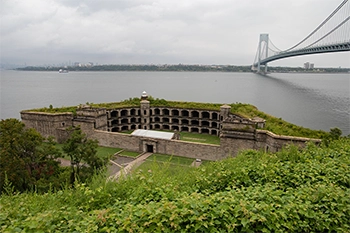
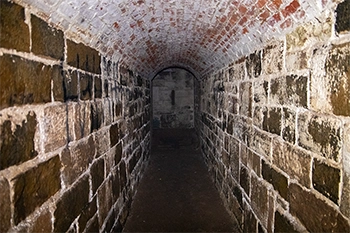 Fort Wadsworth is a group of historic coastal defense batteries and fortifications located on Staten Island in New York and which date back to the U.S. Revolutionary War. The earliest known fortification on the site, however, was a blockhouse which dates back nearly a full century and a half earlier, to 1636. The blockhouse was built on Signal Hill by a Dutch settler by the name of David Pieterszen de Vries. The original blockhouse was subsequently burned in an Indian raid in 1655. A second blockhouse was built in 1663 and survived until the new fortifications were constructed in 1808. During the early stages of the American Revolution the site was a lightly defended and mostly earthenworks fort, or "redoubt", named Fort Flagstaff. This small fort was easily overtaken by the British upon the outset of hostilities in 1776 and it, along with the rest of New York, was occupied by the British until 1783 during which time the British improved and enlarged the fort. Following the British defreat in the war, New York began a massive construction project on Staten Island in the early 1800s to defend the state from invaders and to ensure that it never again fell under the control of a foreign military. Battery Weed and Fort Tompkins were some of the first defenses erected by the state of New York, in 1806 and 1814 respectively.
Fort Wadsworth is a group of historic coastal defense batteries and fortifications located on Staten Island in New York and which date back to the U.S. Revolutionary War. The earliest known fortification on the site, however, was a blockhouse which dates back nearly a full century and a half earlier, to 1636. The blockhouse was built on Signal Hill by a Dutch settler by the name of David Pieterszen de Vries. The original blockhouse was subsequently burned in an Indian raid in 1655. A second blockhouse was built in 1663 and survived until the new fortifications were constructed in 1808. During the early stages of the American Revolution the site was a lightly defended and mostly earthenworks fort, or "redoubt", named Fort Flagstaff. This small fort was easily overtaken by the British upon the outset of hostilities in 1776 and it, along with the rest of New York, was occupied by the British until 1783 during which time the British improved and enlarged the fort. Following the British defreat in the war, New York began a massive construction project on Staten Island in the early 1800s to defend the state from invaders and to ensure that it never again fell under the control of a foreign military. Battery Weed and Fort Tompkins were some of the first defenses erected by the state of New York, in 1806 and 1814 respectively.
Fort Delaware
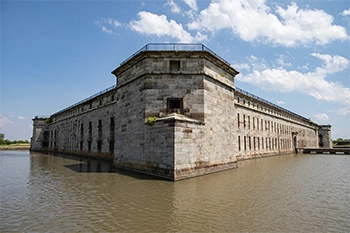
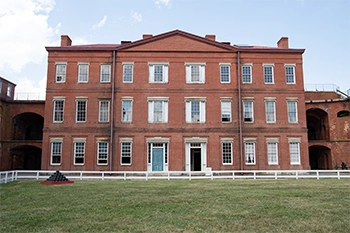 Fort Delaware was constructed between 1848 and 1860 on Pea Patch Island in the Delaware River along the border of Delaware and New Jersey. Fort Delaware was built on the site of a star-shaped fort which was constructed sometime around 1818. The original fort was unintentionally burned down by an Army Corps of Engineers Lt who was sent to repair foundation issues with the original construction. Rubble from the original fort was then used to reinforce the seawall around the island. Fort Delaware has positions for 169 cannons in total with 68 loopholes for muskets and a tier of 11 cannons on the roof. In addition to being on an island, the fort is surrounded by a moat with a tide gate to control the moat's level via a canal from the river. During the Civil War, Fort Delaware was the site of a large POW camp for Confederate prisoners and various political prisoners including several Confederate generals such as Brigadier General Johnston Pettigrew. The Philadephia Inquirer said it "contained an average population of southern tourists who came at the urgent invitation of Mr (Abraham) Lincoln". Among others, most of the prisoners captured at Gettysburg were imprisoned here. By the end of the Civil War, the island fort/prison held nearly 33,000 men. In total, about 2,500 prisoners died on the island.
Fort Delaware was constructed between 1848 and 1860 on Pea Patch Island in the Delaware River along the border of Delaware and New Jersey. Fort Delaware was built on the site of a star-shaped fort which was constructed sometime around 1818. The original fort was unintentionally burned down by an Army Corps of Engineers Lt who was sent to repair foundation issues with the original construction. Rubble from the original fort was then used to reinforce the seawall around the island. Fort Delaware has positions for 169 cannons in total with 68 loopholes for muskets and a tier of 11 cannons on the roof. In addition to being on an island, the fort is surrounded by a moat with a tide gate to control the moat's level via a canal from the river. During the Civil War, Fort Delaware was the site of a large POW camp for Confederate prisoners and various political prisoners including several Confederate generals such as Brigadier General Johnston Pettigrew. The Philadephia Inquirer said it "contained an average population of southern tourists who came at the urgent invitation of Mr (Abraham) Lincoln". Among others, most of the prisoners captured at Gettysburg were imprisoned here. By the end of the Civil War, the island fort/prison held nearly 33,000 men. In total, about 2,500 prisoners died on the island.
Fort Hancock
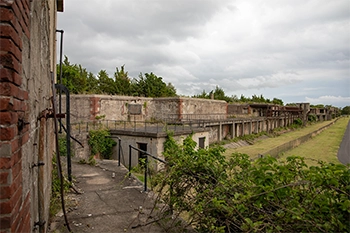
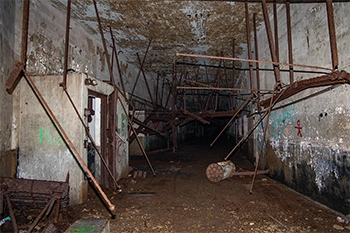 Fort Hancock is a large decommissioned coastal artillery base located in New Jersey which consists of most of the 6-mile long Sandy Hook peninsula near the entrance to New York Harbor. Due to the valuable strategic location of Sandy Hook, this site has had a military presence stationed on it for the 200 years spanning the American Revolution up until December 31, 1974 when it was decomissioned and transferred to the National Park Service. The lighthouse at Sandy Hook was built in 1764 and is the oldest working lighthouse in the United States. A coastal artillery base was completed in 1896 and it defended the Atlantic coast as part of the Harbor Defenses of New York until 1950. The Sandy Hook Proving Ground was established adjacent to Fort Hancock in 1874 as a coastal defense weapons testing area. In 1885, The Endicott Board of Fortifications was convened with the goal of modernizing coastal defense weaponry based on lessons learned in the U.S. Civil War. Fort Hancock was one of the first installations built to prototype the new weapons and defensive systems and it is where the first operational gun of the Endicott Program was deployed and it is the site of the first concrete mortar battery constructed in the United States. Fort Hancock also features the "Nine Gun Battery" which is the longest contiguous gun battery constructed for the Endicott System.
Fort Hancock is a large decommissioned coastal artillery base located in New Jersey which consists of most of the 6-mile long Sandy Hook peninsula near the entrance to New York Harbor. Due to the valuable strategic location of Sandy Hook, this site has had a military presence stationed on it for the 200 years spanning the American Revolution up until December 31, 1974 when it was decomissioned and transferred to the National Park Service. The lighthouse at Sandy Hook was built in 1764 and is the oldest working lighthouse in the United States. A coastal artillery base was completed in 1896 and it defended the Atlantic coast as part of the Harbor Defenses of New York until 1950. The Sandy Hook Proving Ground was established adjacent to Fort Hancock in 1874 as a coastal defense weapons testing area. In 1885, The Endicott Board of Fortifications was convened with the goal of modernizing coastal defense weaponry based on lessons learned in the U.S. Civil War. Fort Hancock was one of the first installations built to prototype the new weapons and defensive systems and it is where the first operational gun of the Endicott Program was deployed and it is the site of the first concrete mortar battery constructed in the United States. Fort Hancock also features the "Nine Gun Battery" which is the longest contiguous gun battery constructed for the Endicott System.
Battery Potter
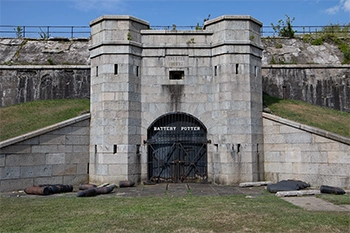
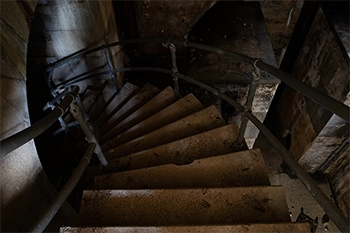 Battery Potter was constructed from 1890-1892 in Fort Hancock, New Jersey. It was the first and only operational disappearing lift-gun in the United States and it was the first Endicott system battery to have been completed and fired. Battery Potter was originally called "Lift-Gun Battery #1" and was constructed at the cost of $357,100. It is a 3-story tall castle-like fortification which used masonry in its construction and which included internal mounts for Gatling guns and rifle slits to defend against landward threats, making it the last battery constructed with those features in the US.
Battery Potter was constructed from 1890-1892 in Fort Hancock, New Jersey. It was the first and only operational disappearing lift-gun in the United States and it was the first Endicott system battery to have been completed and fired. Battery Potter was originally called "Lift-Gun Battery #1" and was constructed at the cost of $357,100. It is a 3-story tall castle-like fortification which used masonry in its construction and which included internal mounts for Gatling guns and rifle slits to defend against landward threats, making it the last battery constructed with those features in the US.
The Armory
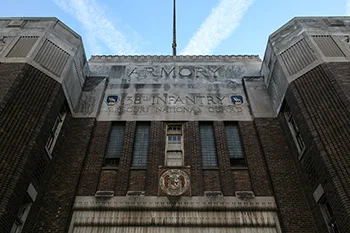
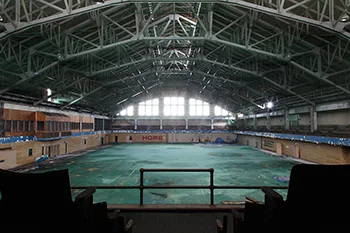 The National Guard Armory was erected in 1937. It went into service in 1939 as the Headquarters of Saint Louis' own 138th Infantry. This building was used, like the other armories, for the purpose of storing ammunition and equipment as well as training soldiers. It remained in use from the time of its initial entry into service in 1939 up until some time in the mid 1960's. The below-ground parking garage housed tanks and other heavy equipment during this time. The building was operated by the 138th as late as 1963...
The National Guard Armory was erected in 1937. It went into service in 1939 as the Headquarters of Saint Louis' own 138th Infantry. This building was used, like the other armories, for the purpose of storing ammunition and equipment as well as training soldiers. It remained in use from the time of its initial entry into service in 1939 up until some time in the mid 1960's. The below-ground parking garage housed tanks and other heavy equipment during this time. The building was operated by the 138th as late as 1963...
WWII Munitions Testing Facility - Saint Louis
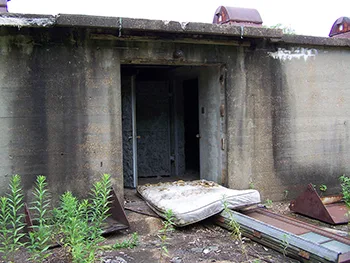
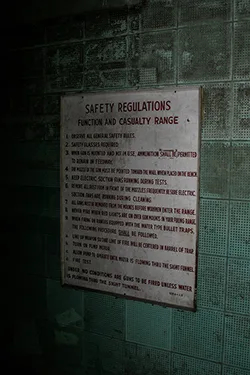 The munitions manufacturing facility that once stood here was built during WWII and saw use through the Vietnam War for the production of ammunition and airplanes. There are tunnels which once connected the factories and provided climate controlled underground storage, evidenced by the large empty rooms and aged compressor equipment. The tunnels themselves stretch for a good mile or so. Along the side of the busy road sits a conspicuous bunker, surrounded by a tall fence which is lined with razor wire. The lack of doors on this structure hints of the tunnels existence below. This small concrete shack was, in fact a machine-gun emplacement. Nearby, a long abandoned munition testing facility slowly crumbles. Falsely assuming there was a connection from the building just down the road, we headed there first. The ammunition produced in the Manufacturing Plant was tested at the Firing Range/Test Laboratory. It has a few small tunnels used for underground 50 cal target practice, but we found they do not connect directly to the main storage bunkers/tunnels. It was in an advanced state of disrepair with the exception of the area used as a firing range which had huge blast doors and reinforced concrete walls. Several nearby warehouses are being rented out, others are sitting vacant. To this day, the area is still mostly Federal Government owned.
The munitions manufacturing facility that once stood here was built during WWII and saw use through the Vietnam War for the production of ammunition and airplanes. There are tunnels which once connected the factories and provided climate controlled underground storage, evidenced by the large empty rooms and aged compressor equipment. The tunnels themselves stretch for a good mile or so. Along the side of the busy road sits a conspicuous bunker, surrounded by a tall fence which is lined with razor wire. The lack of doors on this structure hints of the tunnels existence below. This small concrete shack was, in fact a machine-gun emplacement. Nearby, a long abandoned munition testing facility slowly crumbles. Falsely assuming there was a connection from the building just down the road, we headed there first. The ammunition produced in the Manufacturing Plant was tested at the Firing Range/Test Laboratory. It has a few small tunnels used for underground 50 cal target practice, but we found they do not connect directly to the main storage bunkers/tunnels. It was in an advanced state of disrepair with the exception of the area used as a firing range which had huge blast doors and reinforced concrete walls. Several nearby warehouses are being rented out, others are sitting vacant. To this day, the area is still mostly Federal Government owned.
Cold War Era Storage Bunkers
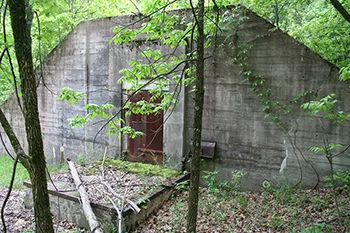
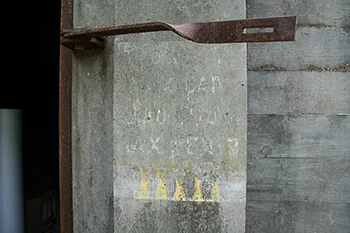 These bunkers were used to store explosives and other munitions during the Cold War. A major Saint Louis business owns it and has an already well secluded location even more well secured. We still managed to find a way in and after hiking for about 8 miles or more, we found a few bunkers. On our way out, we were supposed to take the scenic route and end up in the thick of bunkerland, but we took a wrong turn. At that point it was already late, so we decided to make it a point to return and find the rest some day.
These bunkers were used to store explosives and other munitions during the Cold War. A major Saint Louis business owns it and has an already well secluded location even more well secured. We still managed to find a way in and after hiking for about 8 miles or more, we found a few bunkers. On our way out, we were supposed to take the scenic route and end up in the thick of bunkerland, but we took a wrong turn. At that point it was already late, so we decided to make it a point to return and find the rest some day.
Mechanical City
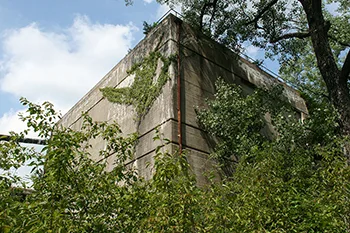
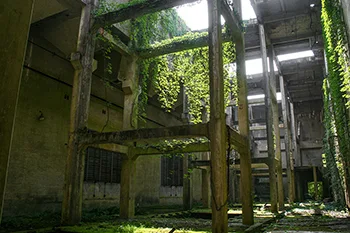 Hiding in the woods and thick overgrowth lie several deserted and almost completely forgotten behemoths of early-to-mid 20th century industry. I know only that these buildings were in some way originally involved in the processing of stone mined locally and were used in the construction of what was to be a massive scientific-industrial complex. I read they also had repair shops and all kinds of other factories out here, all working for a common interest. Their impressive size and the noises they once emitted earned them the collective title of "Mechanical City". Their individual, specific uses are beyond any guess I could possibly make but I am familiar with the buildings that these had been designed to help construct. This site is closely related to two nearby and much more well-known locations. In fact, it was built to facilitate their construction, one of which is the former Weldon Springs Ordnance Works, known to locals as the "Equadome". If you lived in Saint Charles up until the late '90s, you probably at least heard of the 'dome. It was built to produce TNT and other munitions during WWII. I know of no other place that had so many rumors attributed to it; from the supposed site of Satan worship, to several rapes and a death or two, it had quite the reputation. It was a massive industrial playground and was abandoned in the 60s. Unfortunately, it was demolished in 1998. It was built to withstand ordnance explosions and as a result proved to be very difficult to finally demolish. I was fortunate to have explored it several times, but I had no camera back then.
Hiding in the woods and thick overgrowth lie several deserted and almost completely forgotten behemoths of early-to-mid 20th century industry. I know only that these buildings were in some way originally involved in the processing of stone mined locally and were used in the construction of what was to be a massive scientific-industrial complex. I read they also had repair shops and all kinds of other factories out here, all working for a common interest. Their impressive size and the noises they once emitted earned them the collective title of "Mechanical City". Their individual, specific uses are beyond any guess I could possibly make but I am familiar with the buildings that these had been designed to help construct. This site is closely related to two nearby and much more well-known locations. In fact, it was built to facilitate their construction, one of which is the former Weldon Springs Ordnance Works, known to locals as the "Equadome". If you lived in Saint Charles up until the late '90s, you probably at least heard of the 'dome. It was built to produce TNT and other munitions during WWII. I know of no other place that had so many rumors attributed to it; from the supposed site of Satan worship, to several rapes and a death or two, it had quite the reputation. It was a massive industrial playground and was abandoned in the 60s. Unfortunately, it was demolished in 1998. It was built to withstand ordnance explosions and as a result proved to be very difficult to finally demolish. I was fortunate to have explored it several times, but I had no camera back then.
Mechanical City Pt. II
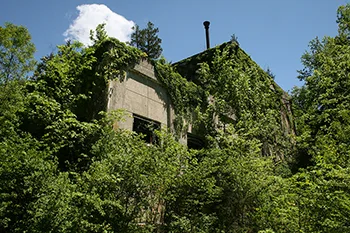
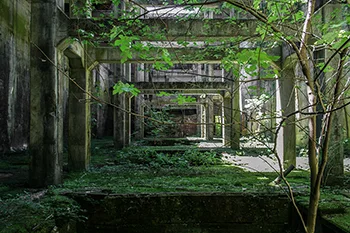 On this trip, we visited the East side of Mechanical City and found more random buildings scattered in the woods. The largest of these closely resembles one I visited previously on the Western edge, several miles away.
On this trip, we visited the East side of Mechanical City and found more random buildings scattered in the woods. The largest of these closely resembles one I visited previously on the Western edge, several miles away.
Fort Belle Fontaine
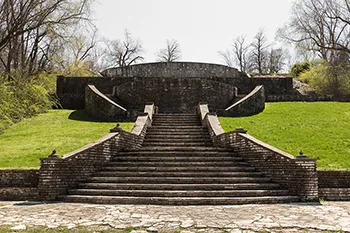
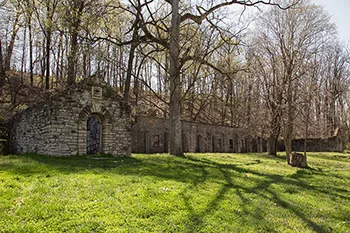 "Fort Bellefontaine was the first United States military installation west of the Mississippi in the new Louisiana Territory. Located on the south bank of the Missouri River, in present-day Missouri, Fort Bellefontaine was first a Spanish military post. After the Louisiana Purchase, by a treaty made between the United States Government, signed by William H. Harrison and representatives of the Native American Sac and Fox tribes (on November 3, 1804), the fort became a fur trading post of the United States Government. Rudolf Tiller served as factor and Col. Thomas Hunt served as first in command. The trading post was discontinued after 1808, and from 1809 to 1826 the facility served as a United States military fort. During that time period, from about 1809 to 1815, the fort served as the headquarters of the Department of Louisiana, and was the regional Army headquarters during the War of 1812. Its sister forts were Fort Osage along the Missouri near modern Kansas City, which controlled trade with western Indians; and Fort Madison in what is now Iowa, which controlled trade of the Upper Mississippi. Lewis and Clark's Corps of Discovery expedition (1804-1806) spent the first night of their expedition on an island opposite Cold Water Creek and their last night two years later at the fort, which had been established in their absence. Other major expeditions left from this site betweem 1805 and 1819 to explore the newly acquired Louisiana Territory. Until it was replaced by Jefferson Barracks in 1826, Fort Belle Fontaine was an important gathering place in the wilderness for officers and enlisted men, Native American, French, Spanish and American settlers, trappers and traders, and the local businessmen and farmers who supplied the fort with necessities." Today it is a scenic park and is open to the public.
"Fort Bellefontaine was the first United States military installation west of the Mississippi in the new Louisiana Territory. Located on the south bank of the Missouri River, in present-day Missouri, Fort Bellefontaine was first a Spanish military post. After the Louisiana Purchase, by a treaty made between the United States Government, signed by William H. Harrison and representatives of the Native American Sac and Fox tribes (on November 3, 1804), the fort became a fur trading post of the United States Government. Rudolf Tiller served as factor and Col. Thomas Hunt served as first in command. The trading post was discontinued after 1808, and from 1809 to 1826 the facility served as a United States military fort. During that time period, from about 1809 to 1815, the fort served as the headquarters of the Department of Louisiana, and was the regional Army headquarters during the War of 1812. Its sister forts were Fort Osage along the Missouri near modern Kansas City, which controlled trade with western Indians; and Fort Madison in what is now Iowa, which controlled trade of the Upper Mississippi. Lewis and Clark's Corps of Discovery expedition (1804-1806) spent the first night of their expedition on an island opposite Cold Water Creek and their last night two years later at the fort, which had been established in their absence. Other major expeditions left from this site betweem 1805 and 1819 to explore the newly acquired Louisiana Territory. Until it was replaced by Jefferson Barracks in 1826, Fort Belle Fontaine was an important gathering place in the wilderness for officers and enlisted men, Native American, French, Spanish and American settlers, trappers and traders, and the local businessmen and farmers who supplied the fort with necessities." Today it is a scenic park and is open to the public.

